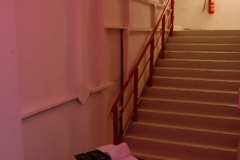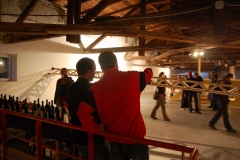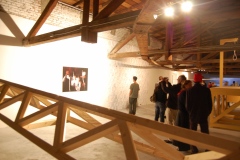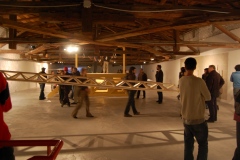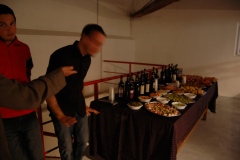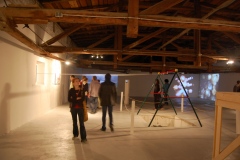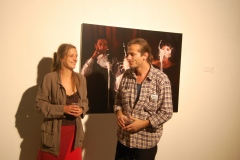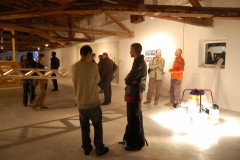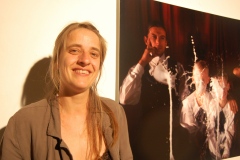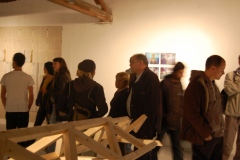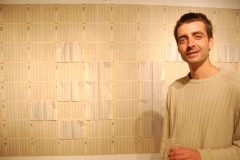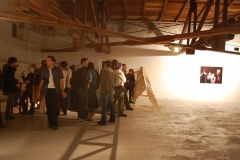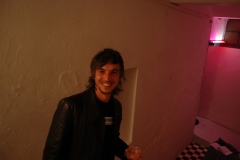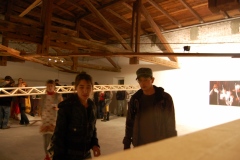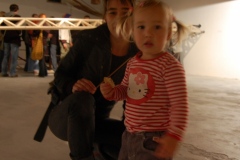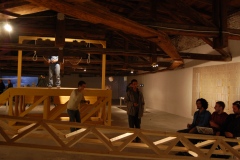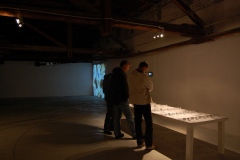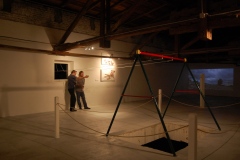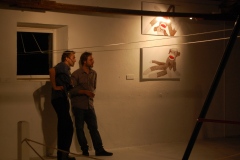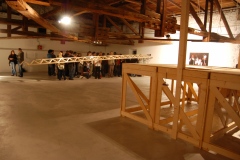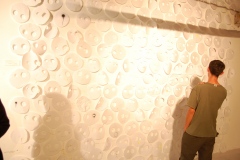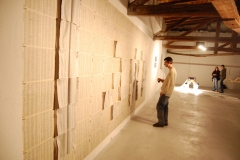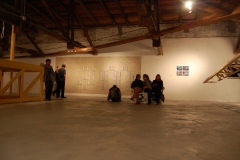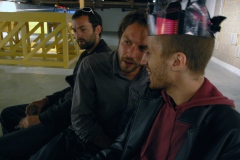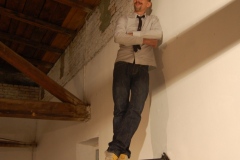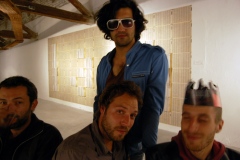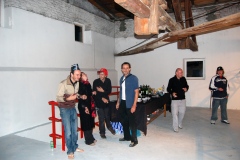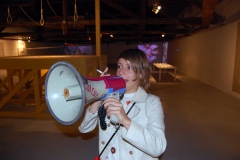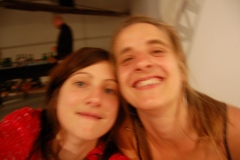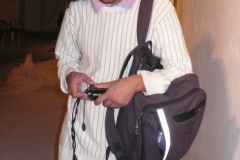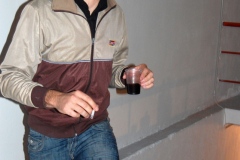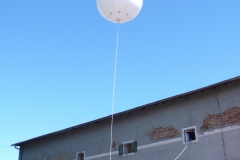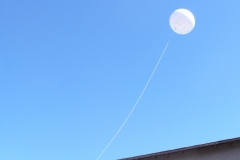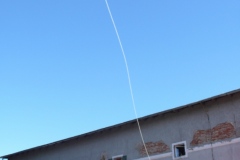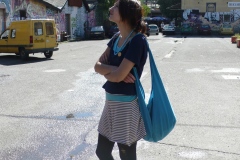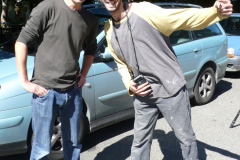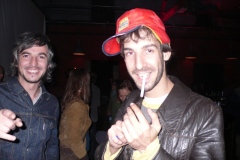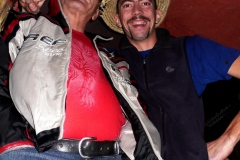1469 m3 / 8 m3 = {11 sept – 11 nov}
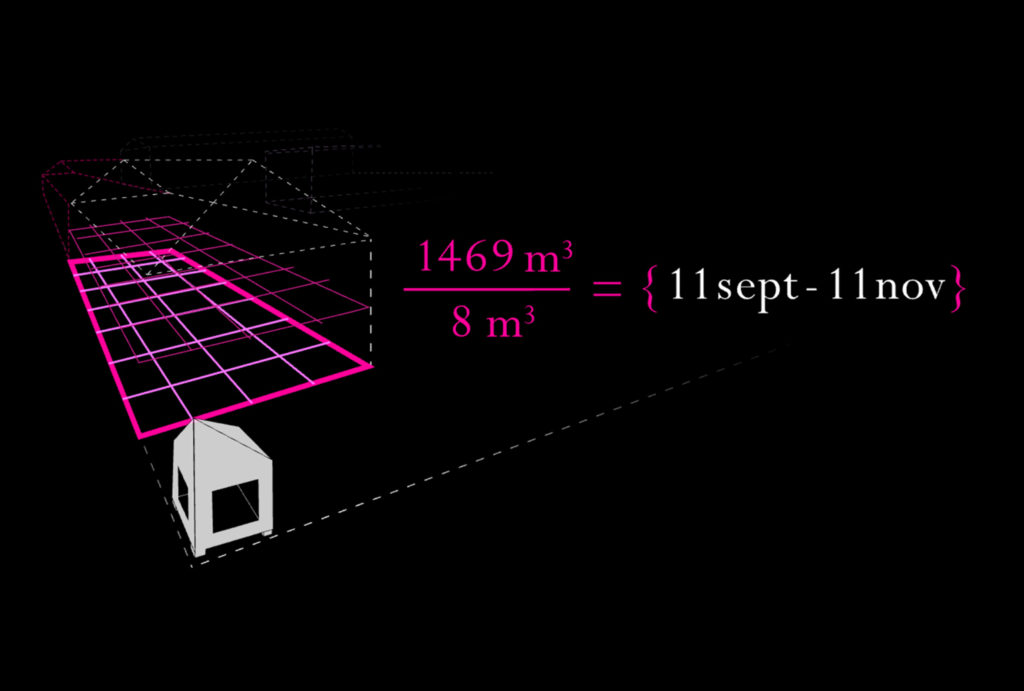
1469 m3 / 8 m3= {11 sept – 11 nov}
Exposition collective – Group show
Hladilnica, Centre Culturel Pekarna, Maribor, Slovénie – Hladilnica, Pekarna Cultural Centre, Maribor, Slovenia
*
Avec les artistes – with the artists: Pierluigi Anselmi (It), Maxime Berthou (Monsieur Moo) (Fr), Rémi Bragard (Fr), Paul Destieu (Fr), Ivan DVORŠAK (Slo), Polonca Lovšin (Slo), Antoine Milian (Fr), Luce Moreau (Fr), Olivier Morvan (Fr), Patrik Ševčík (Sk), Pascual Sisto (Us), son :DA ( Slo), Cathy Weyders (Be), Colson Wood (Fr)
Exposition collective : du 11 Septembre au 11 Novembre 2007 – Group show: from September 11th to November 11th, 2007
Vernissage : mardi 11 Septembre 2007 à partir de 19h – Opening: Tuesday September 11th, 2007, starting at 7 p.m.
Pour la toute première fois à Maribor, OTTO-Prod organise une exposition collective rassemblant les artistes exposés dans le cadre du showroom La Vitrine durant l’année écoulée, ainsi que trois nouveaux participants à venir. Une exposition pour laquelle ces artistes internationaux sont invités à présenter une nouvelle œuvre.
Le titre de l’exposition 1469m³ / 8m³ = {11sept–11nov} fait référence aux volumes des espaces nouvellement investis par OTTO-Prod au sein du Centre Culturel Pekarna :
La Vitrine : un showroom de 2x2x2m, accessible 24h/24. Hlaldilnica : un plateau d’exposition de 300m² avec une hauteur sous plafond de 2,20m autrefois utilisé comme chambre froide de la boulangerie militaire.
Une exposition produite par OTTO-Prod, en partenariat avec Pekarna MM.
Remerciement : Borut Wenzel, Urko, Sara Zupanc, Dolores, Ciko, Matej Dečko & family, Infopeka, Gustaf, Jelena, Marjan, Marko
For the very first time in Maribor, OTTO-Prod is organizing a group exhibition bringing together artists who exhibited in the La Vitrine showroom over the past year, along with three new upcoming participants. An exhibition where these international artists are invited to present a new artwork.
The title of the exhibition 1469m³ / 8m³ = {11sept–11nov} refers to the volumes of the spaces recently used by OTTO-Prod within the Pekarna Cultural Centre:
La Vitrine – a 2x2x2m showroom accessible 24/7.
Hlaldilnica – a 300m² exhibition space with a ceiling height of 2.20m, formerly used as the cold room of the military bakery.
An exhibition produced by OTTO-Prod, in partnership with the Pekarna MM.
Special thanks to: Borut Wenzel, Urko, Sara Zupanc, Dolores, Ciko, Matej Dečko & family, Infopeka, Gustaf, Jelena, Marjan, Marko
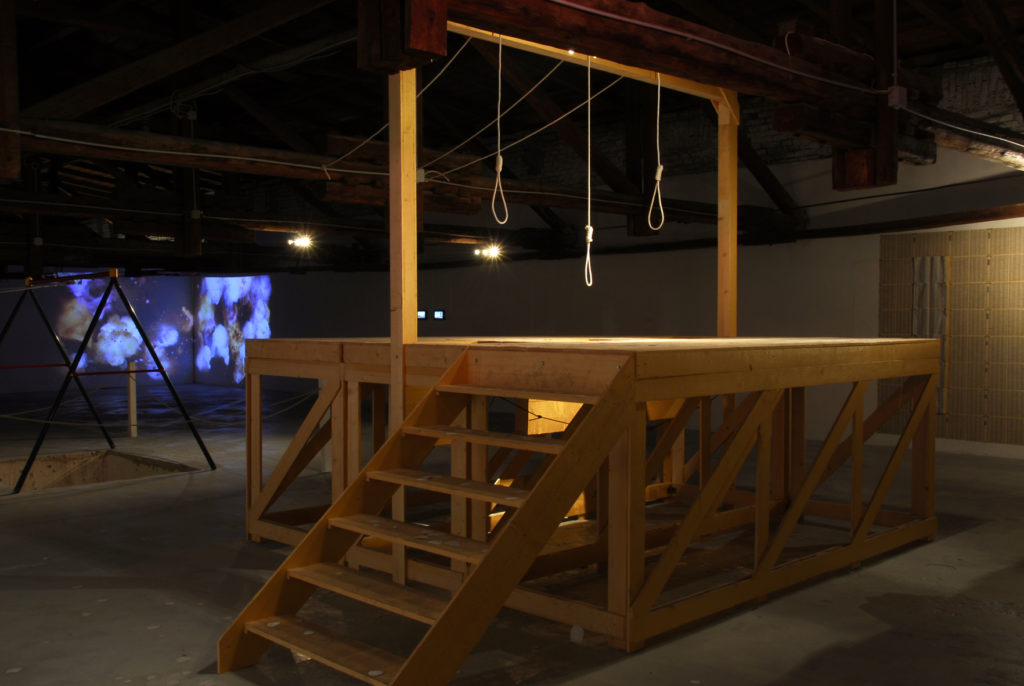
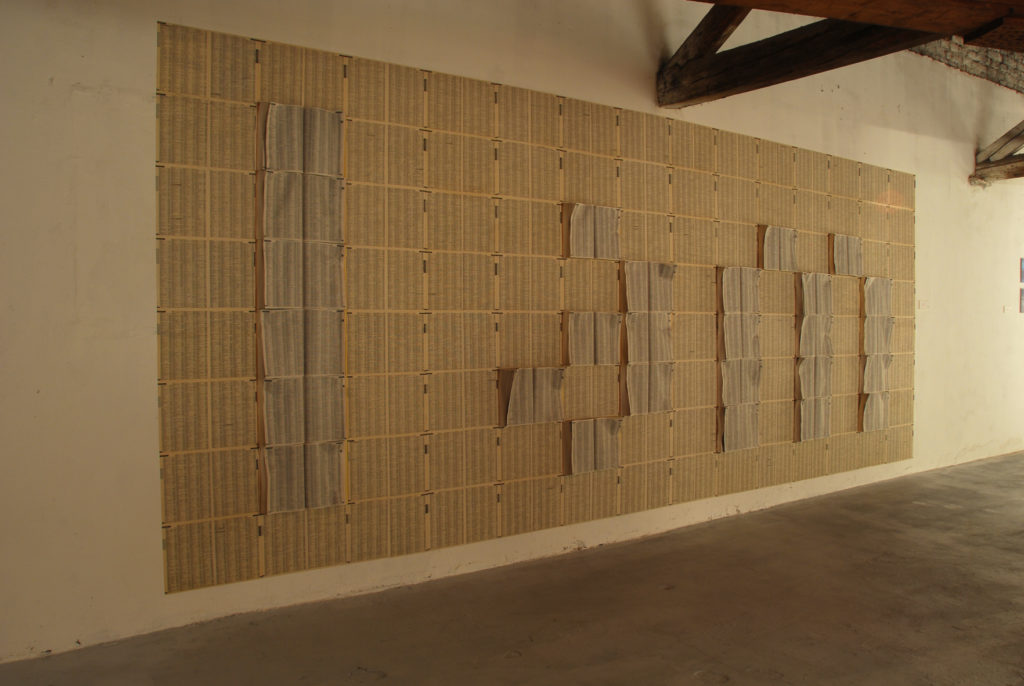
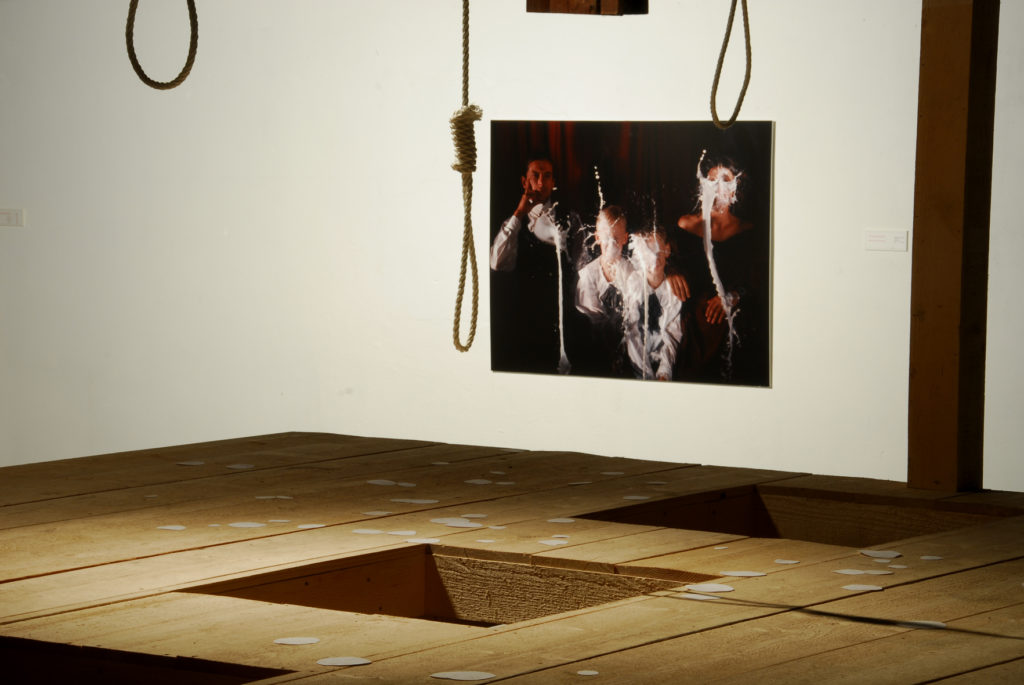
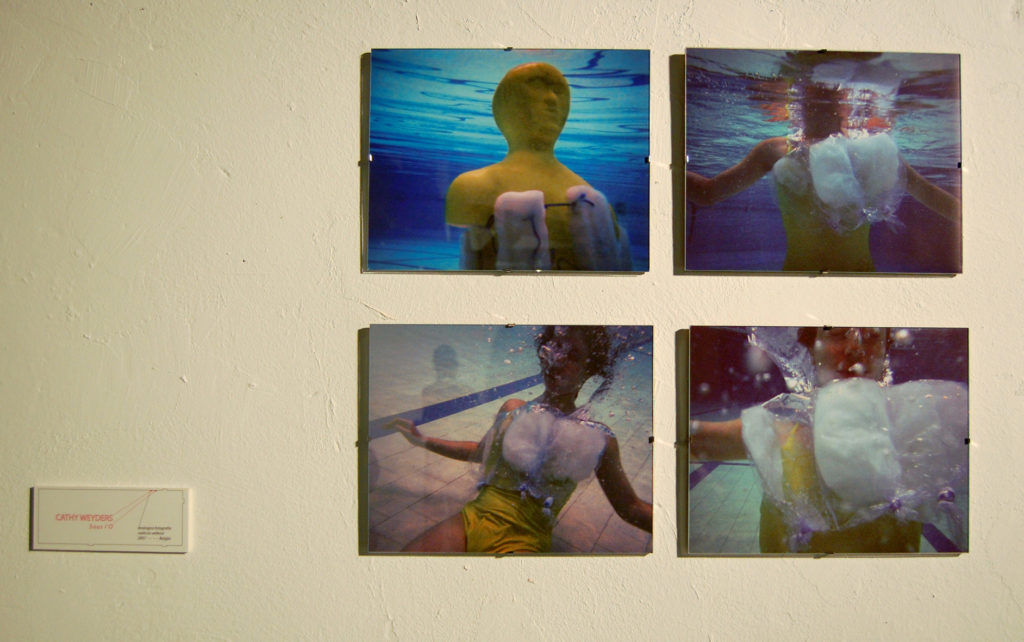
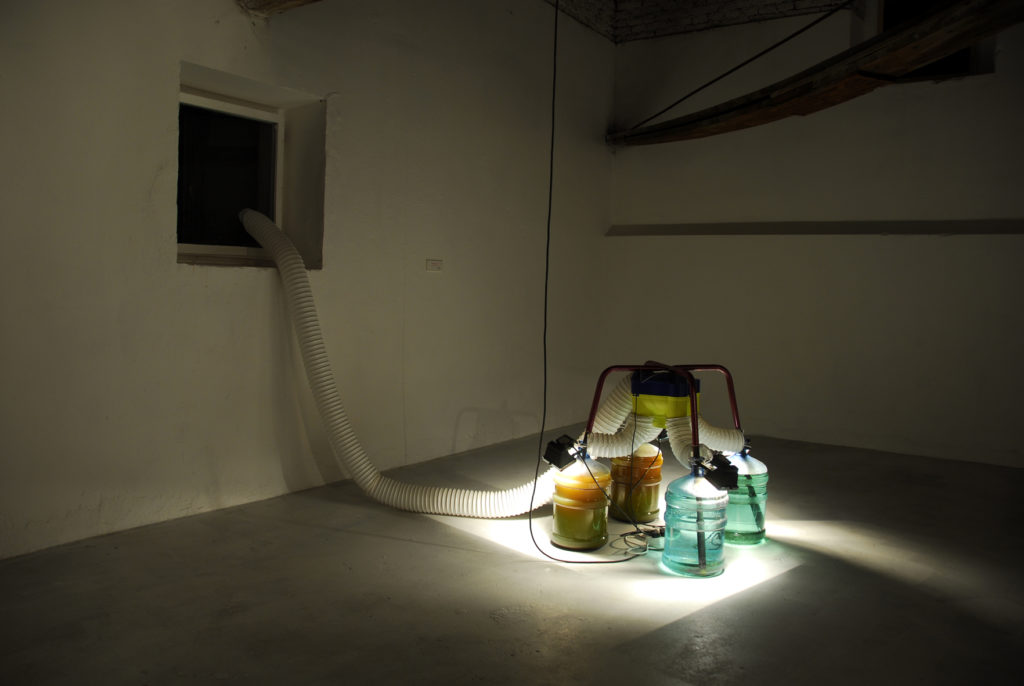
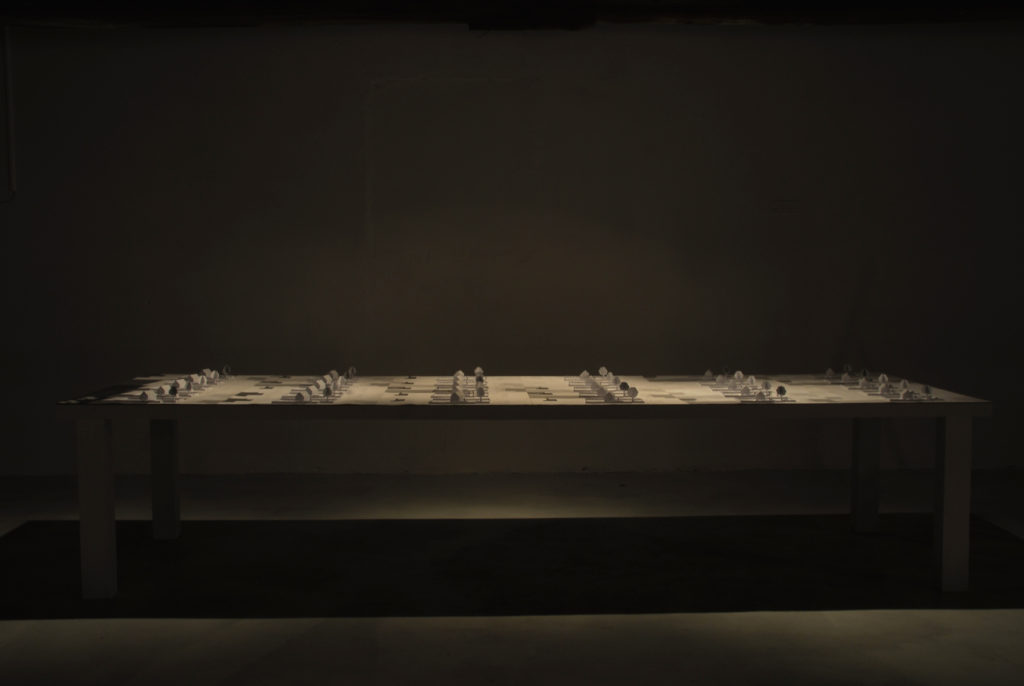
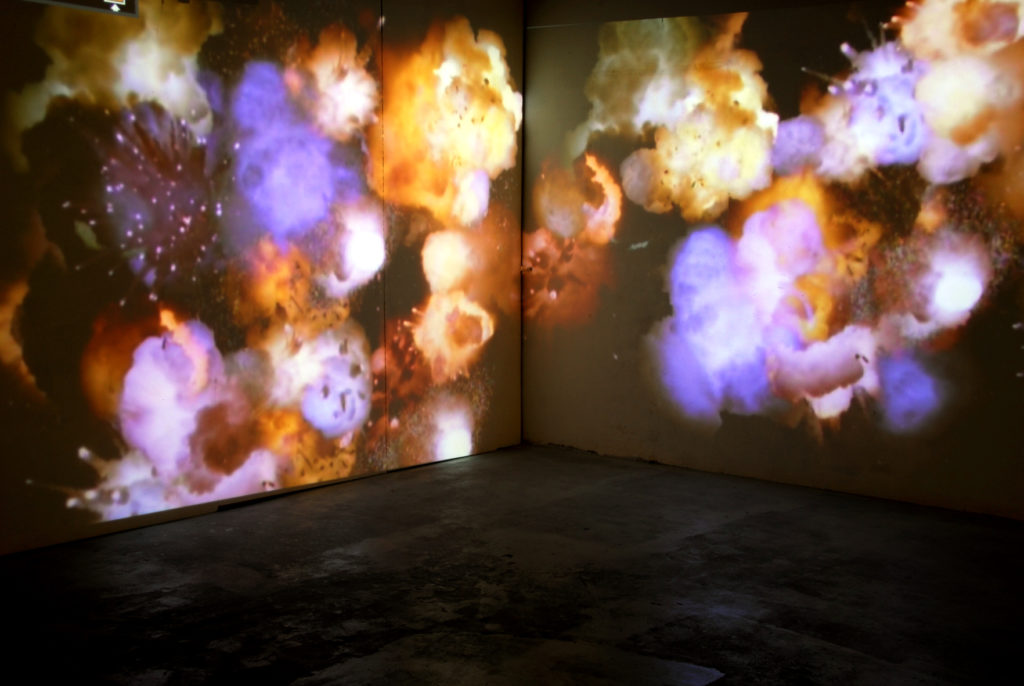
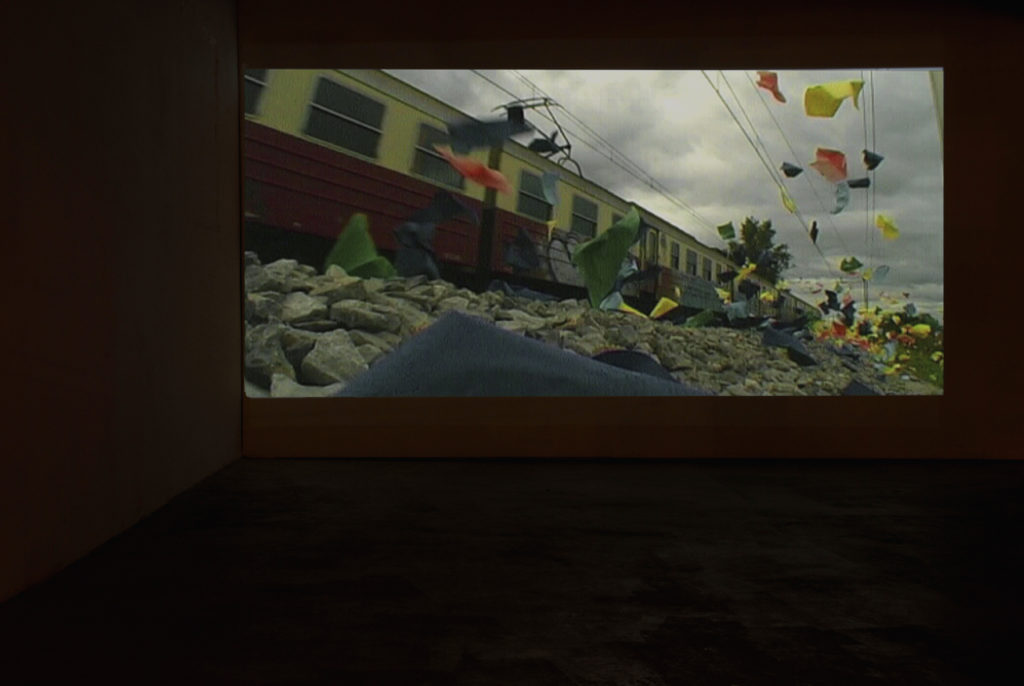
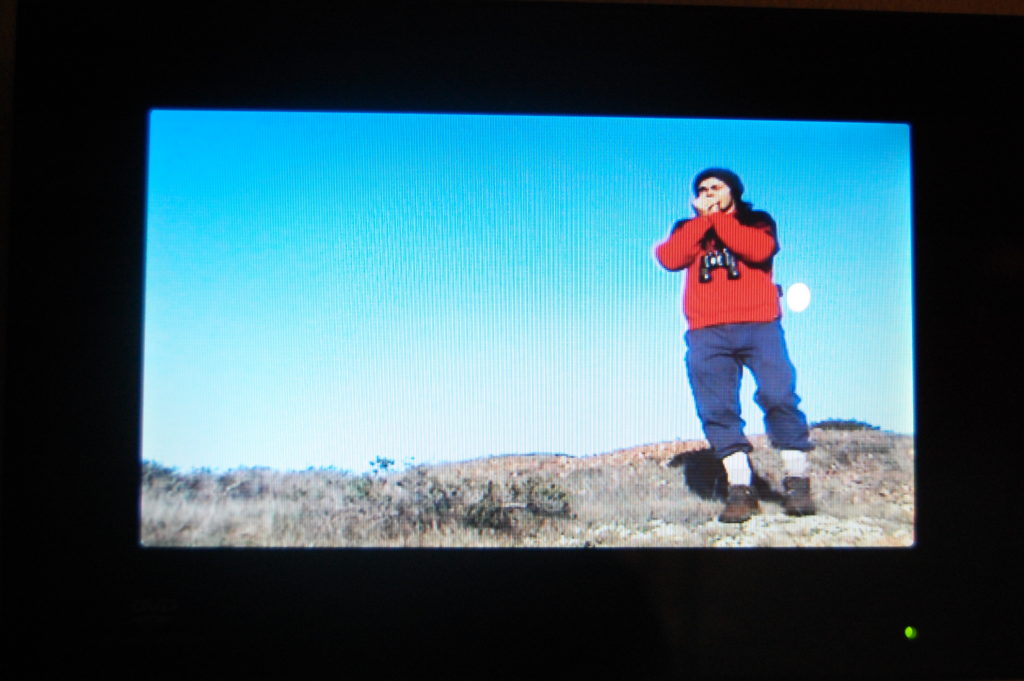
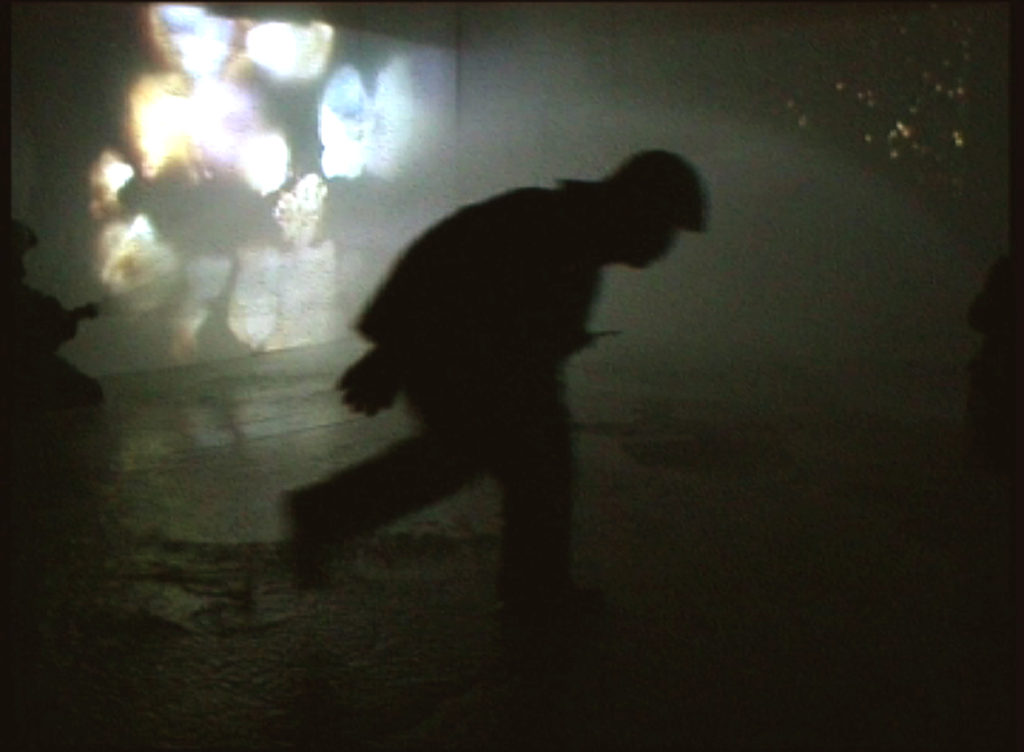
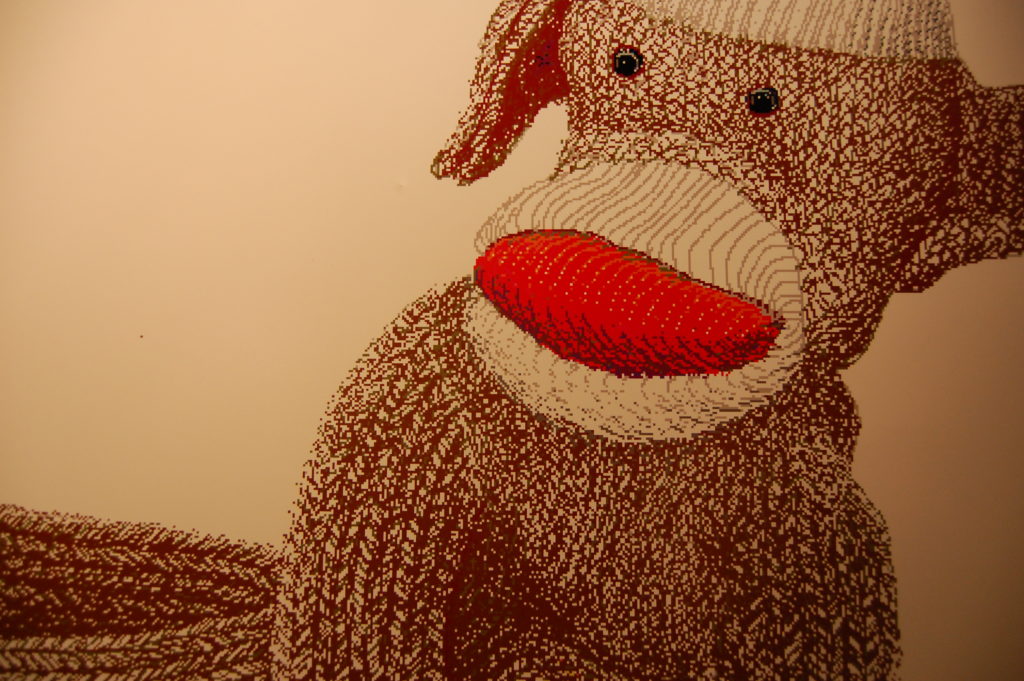
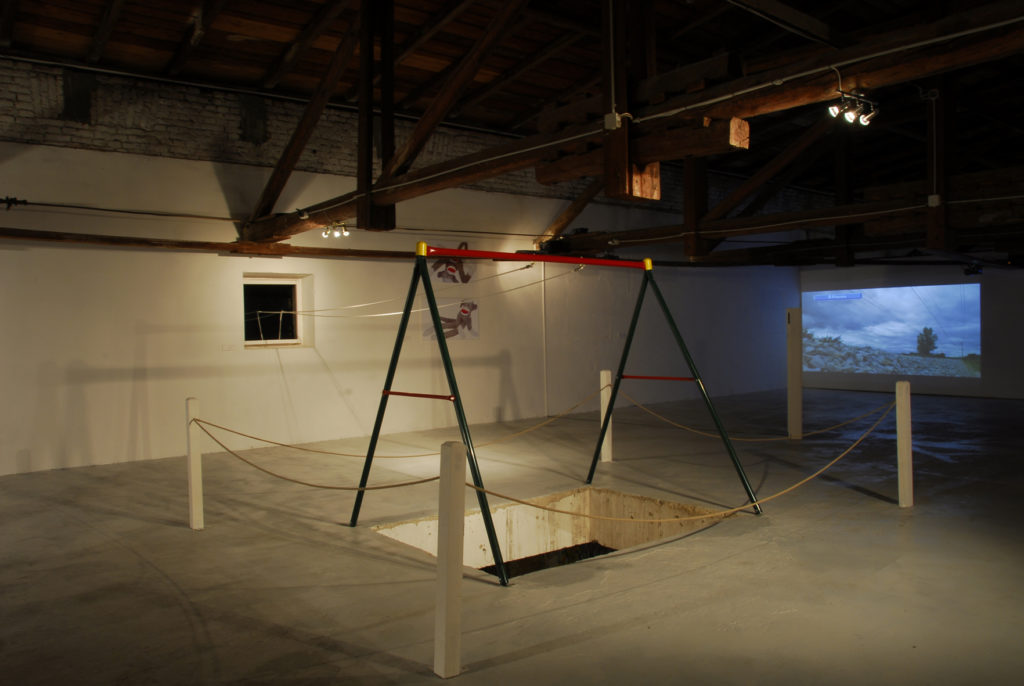
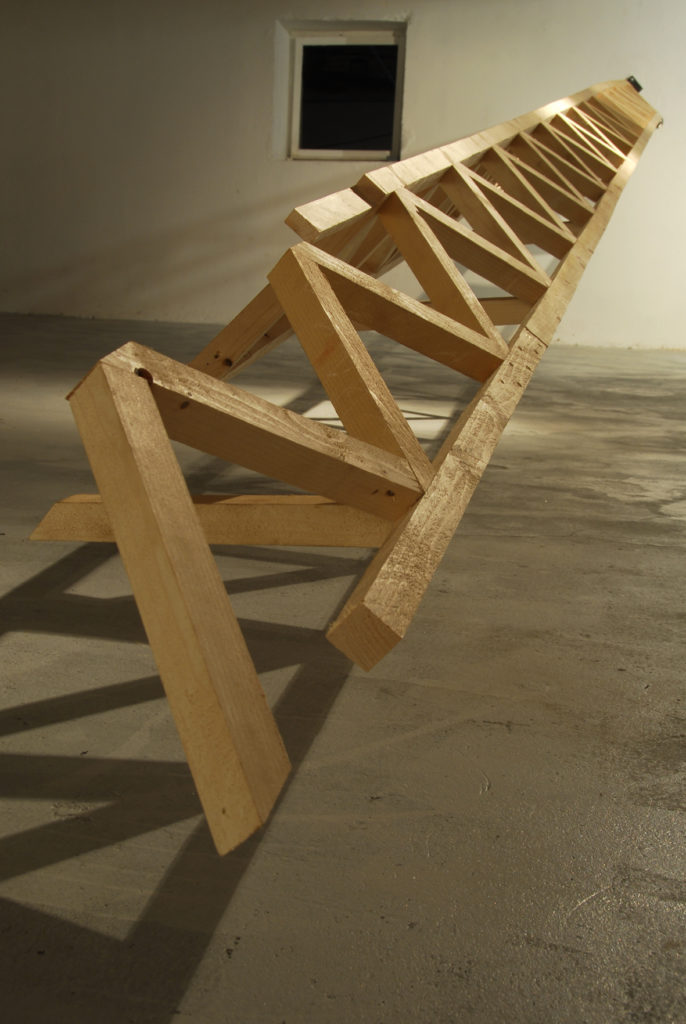
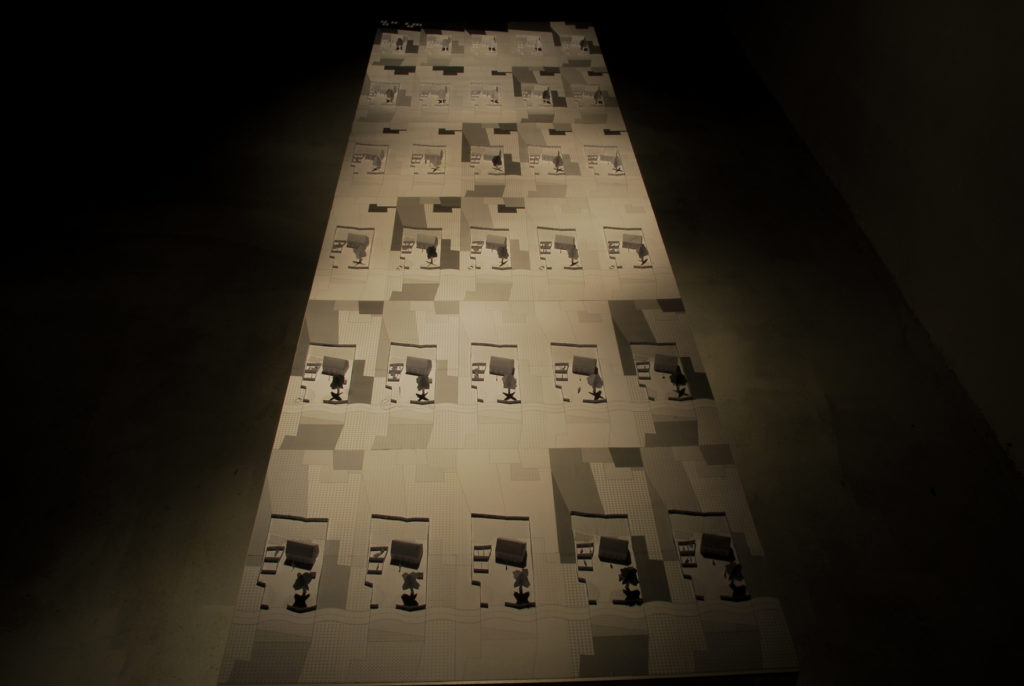
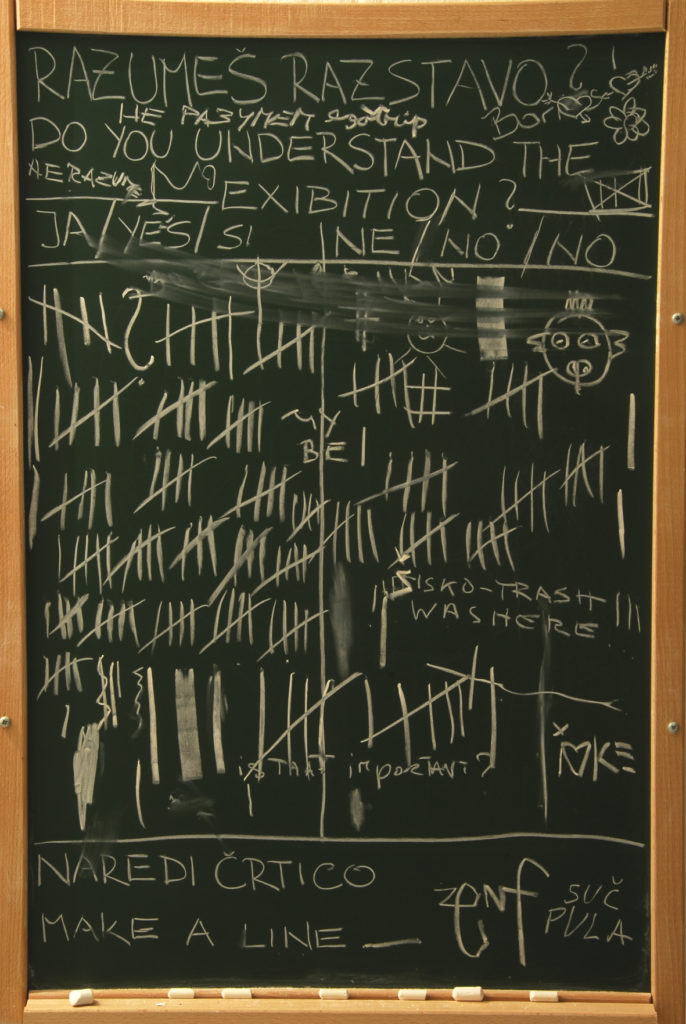
Altalena di Maribor (fuga)
Techniques mixtes – Mixed media, 2007
Pierluigi Anselmi (It)
Production : OTTO-Prod
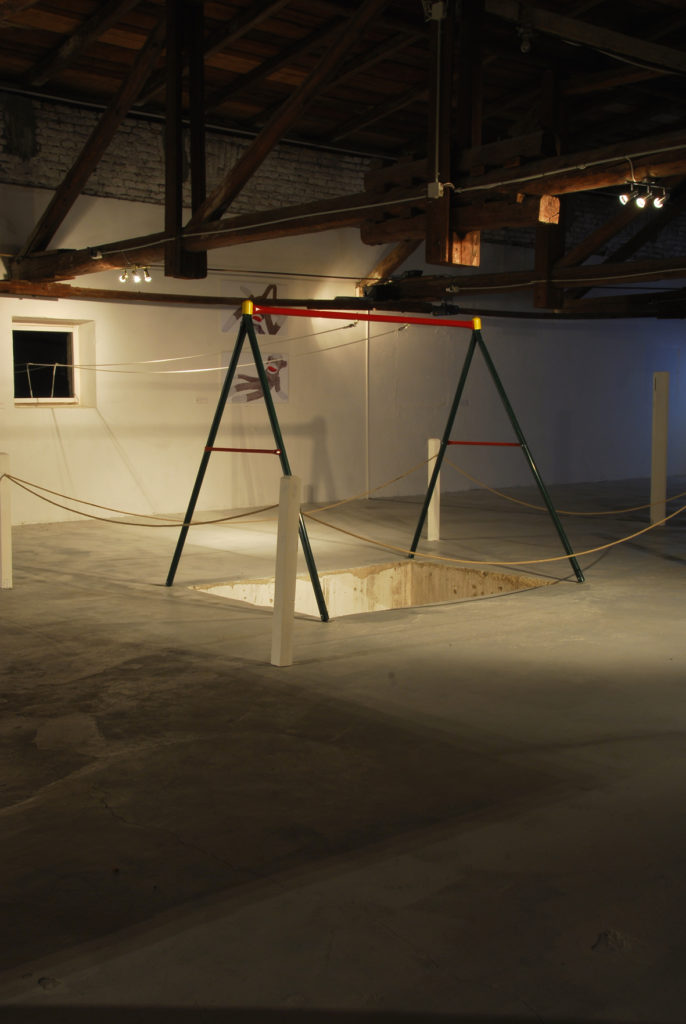
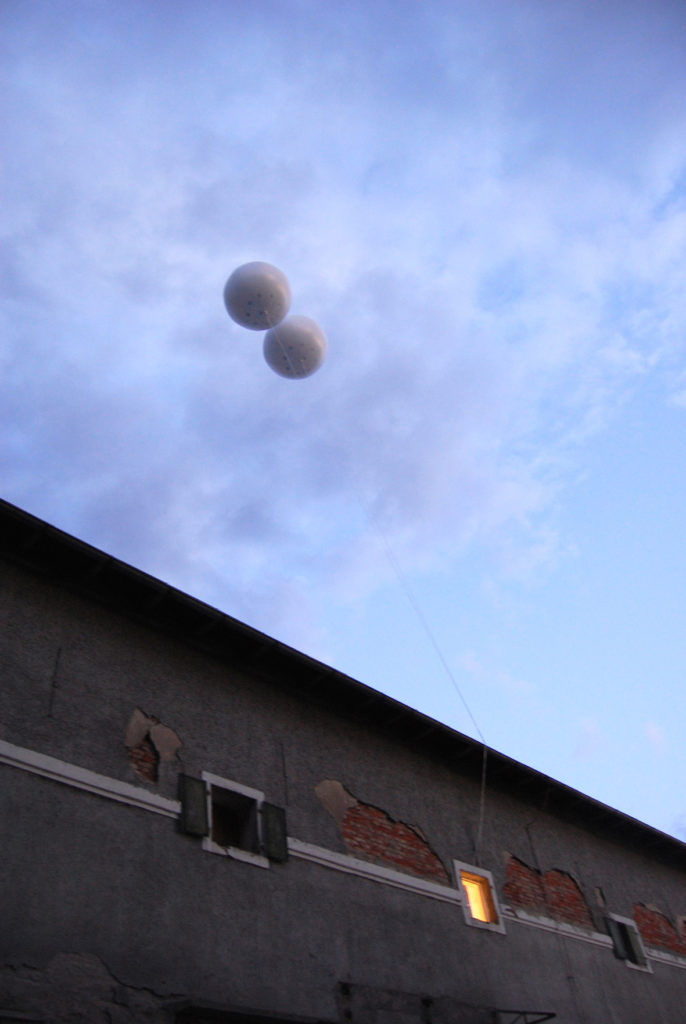
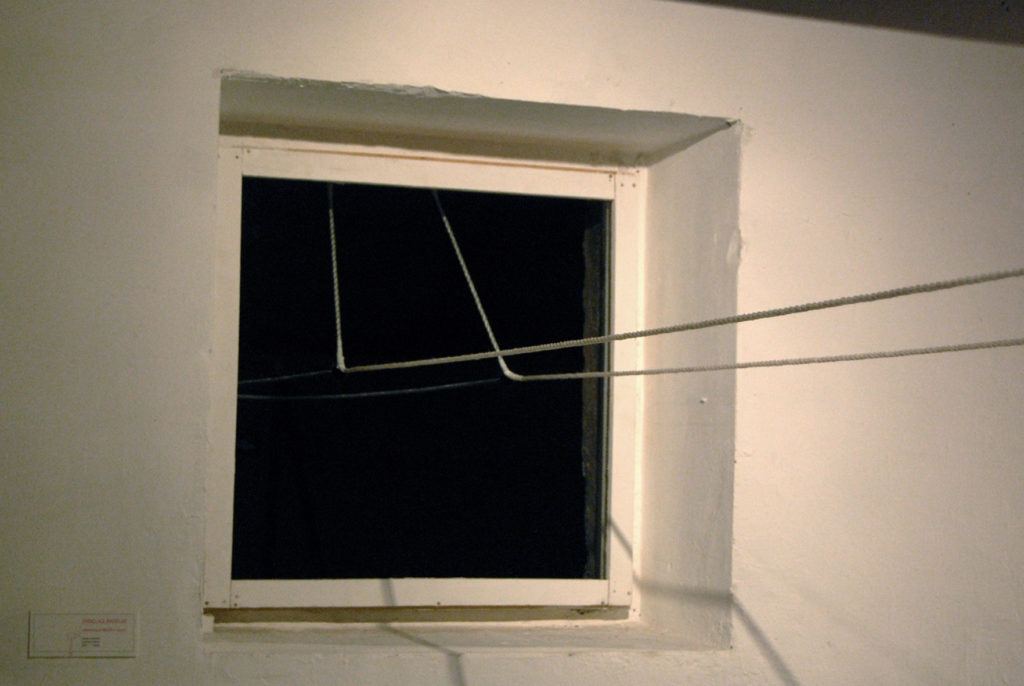
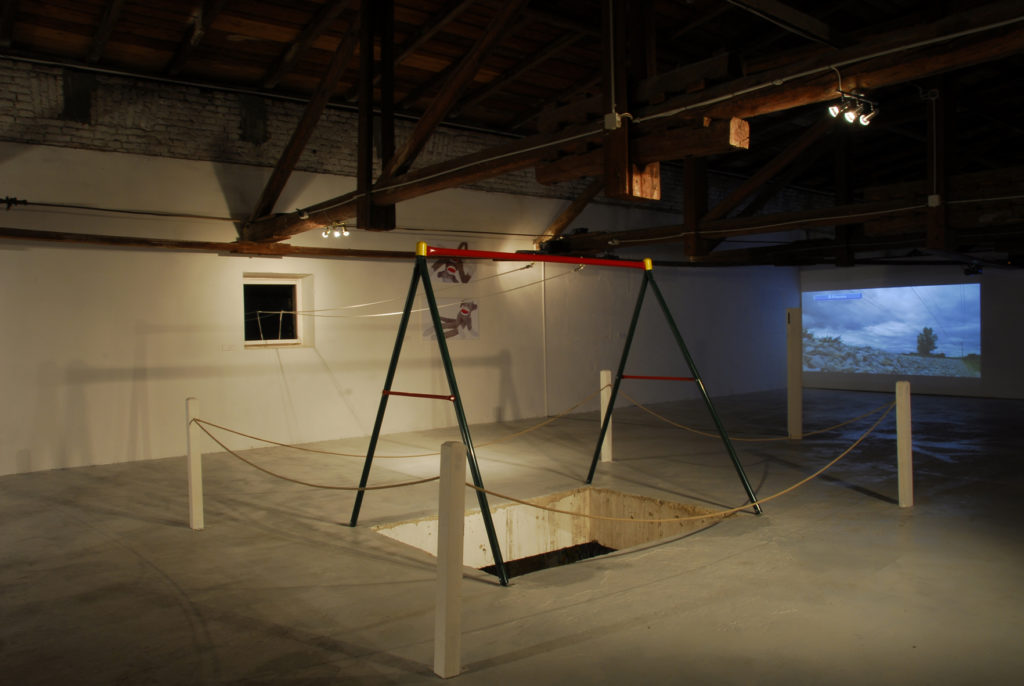
Pierluigi Anselmi explore une réalité revisitée à travers divers média. En intégrant les possibilités offertes par chaque lieu, chaque œuvre prend forme par un processus conceptuel plutôt qu’un style prédéfini. Même les erreurs ou malentendus deviennent des leviers pour réinventer sujet et langage. Par un travail poétique, il invite le spectateur à inventer sa propre fiction, dans un élan d’imaginaire enfantin. À travers un travail poétique, Pierluigi Anselmi invite le spectateur à apposer sa propre fiction : la narration demande un effort enfantin pour plonger dans la part fabuleuse du récit.
Pierluigi Anselmi explores a revisited reality through various media. By integrating the possibilities offered by each location, every work takes shape through a conceptual process rather than a predefined style. Even mistakes or misunderstandings turn into opportunities to reinvent the subject and its grammar. Through a poetic work, Pierluigi Anselmi invites the viewer to project their own narrative: storytelling requires a childlike effort to dive into the fabulous side of the tale.
Feedback to Salamander
Installation vidéo – Video installation, 2007
Maxime Berthou (Monsieur Moo) (Fr)
Production : OTTO-Prod
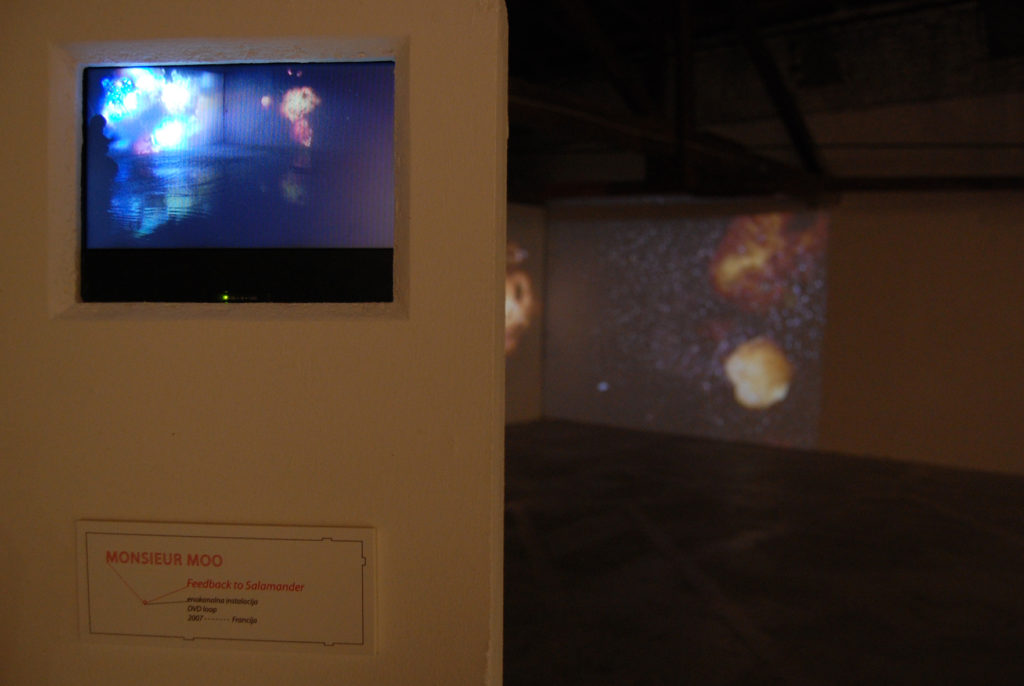
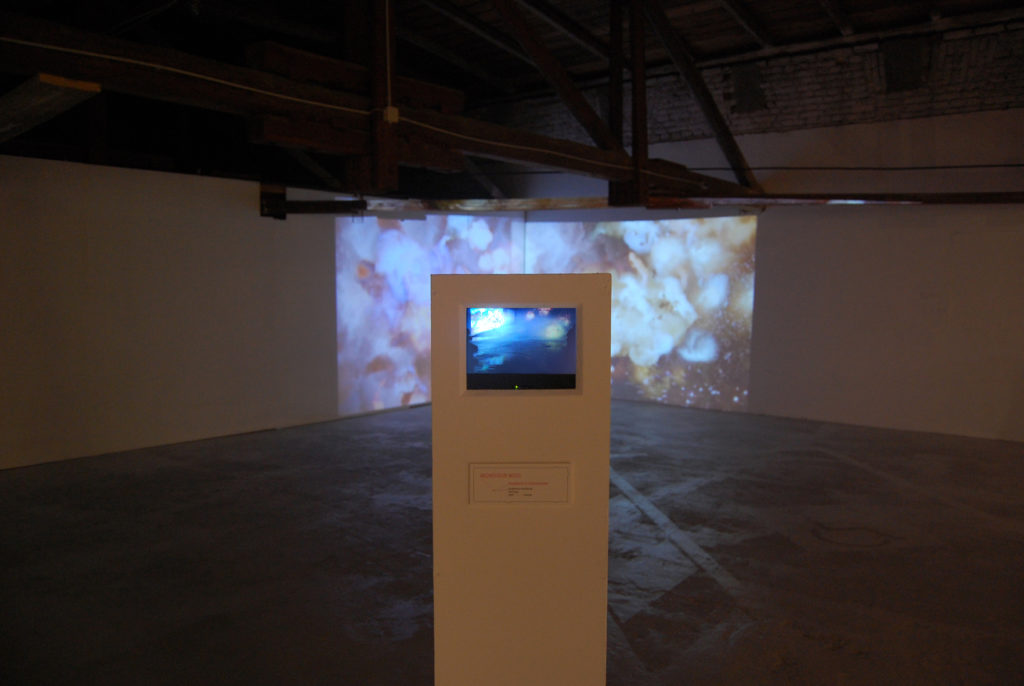
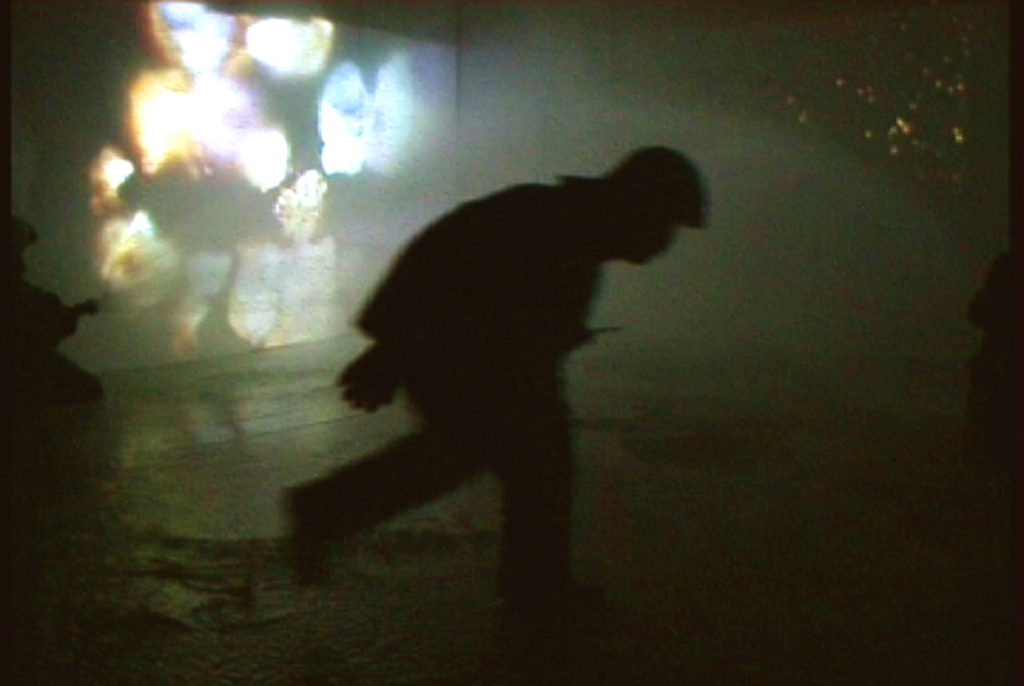
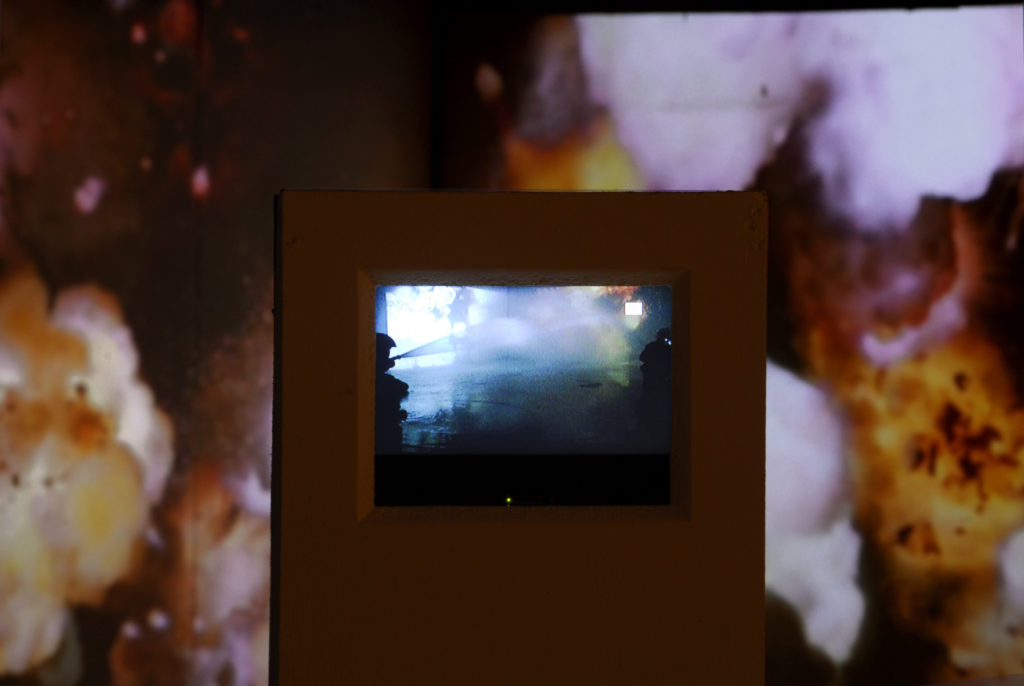
Maxime Berthou (Monsieur Moo) explore les collisions créatives à travers des collaborations avec des artistes visuels, danseurs, musiciens et artisans. En confrontant son univers à celui des autres, il génère tensions, frictions et interférences poétiques. Ces rencontres aboutissent à des protocoles performatifs documentés en vidéo, révélant l’intensité brute née de la confrontation artistique.
Maxime Berthou (Monsieur Moo) explores creative collisions through collaborations with visual artists, dancers, musicians, and artisans. By confronting his universe with others, he generates tensions, frictions, and poetic interferences. These encounters culminate in performative processes, documented through video, revealing the raw intensity born from artistic confrontation.
Corrosion organisée
Techniques mixtes – Mixed media, 2007
Rémi Bragard (Fr)
Production : OTTO-Prod
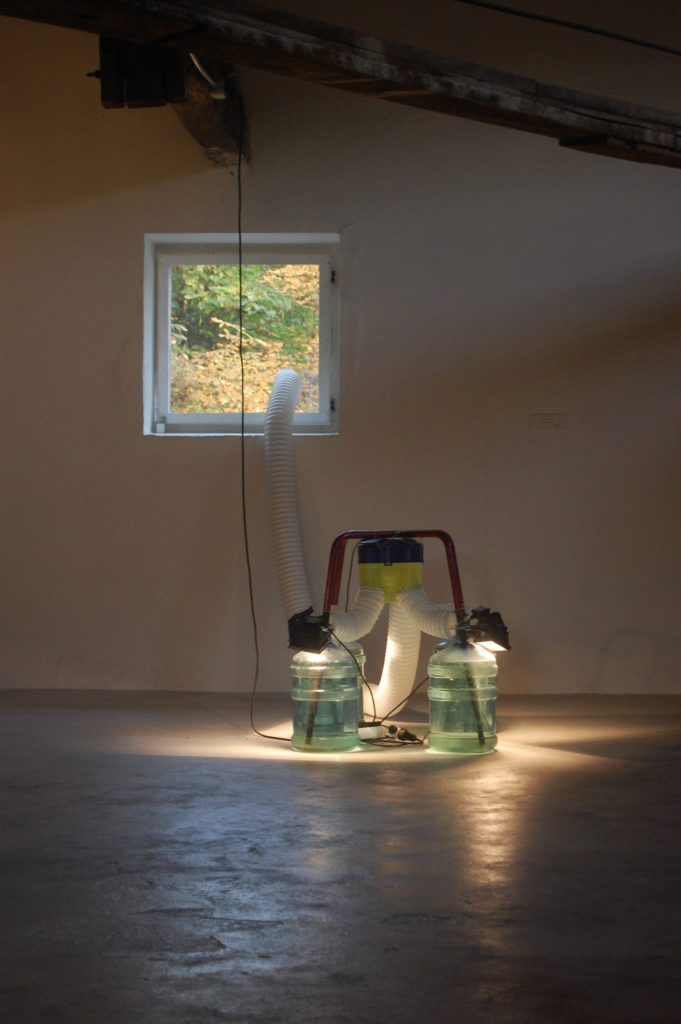
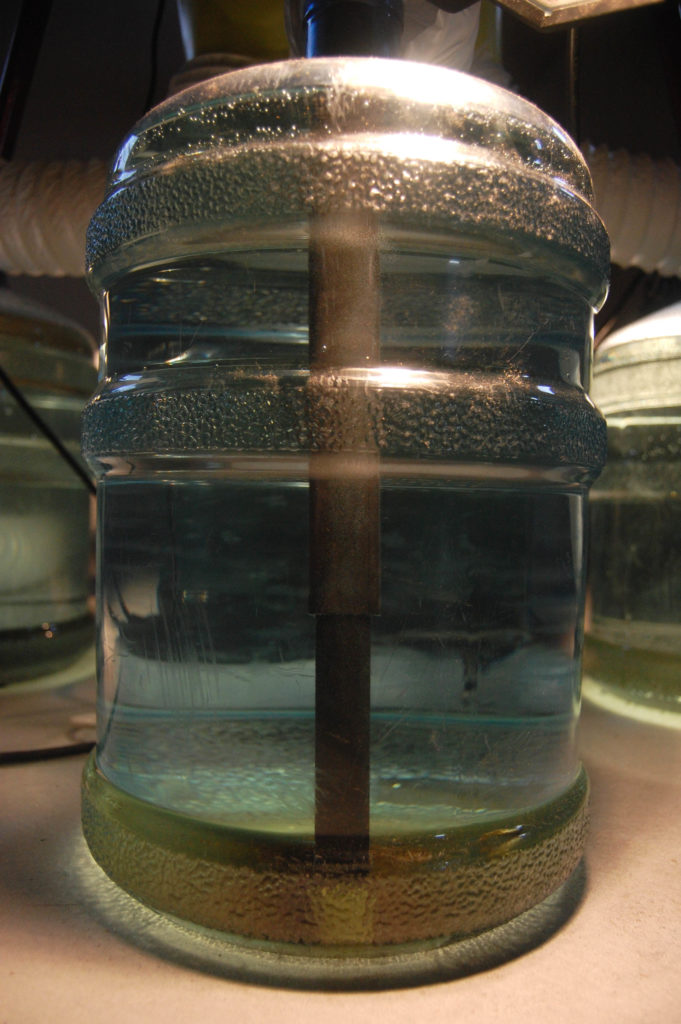
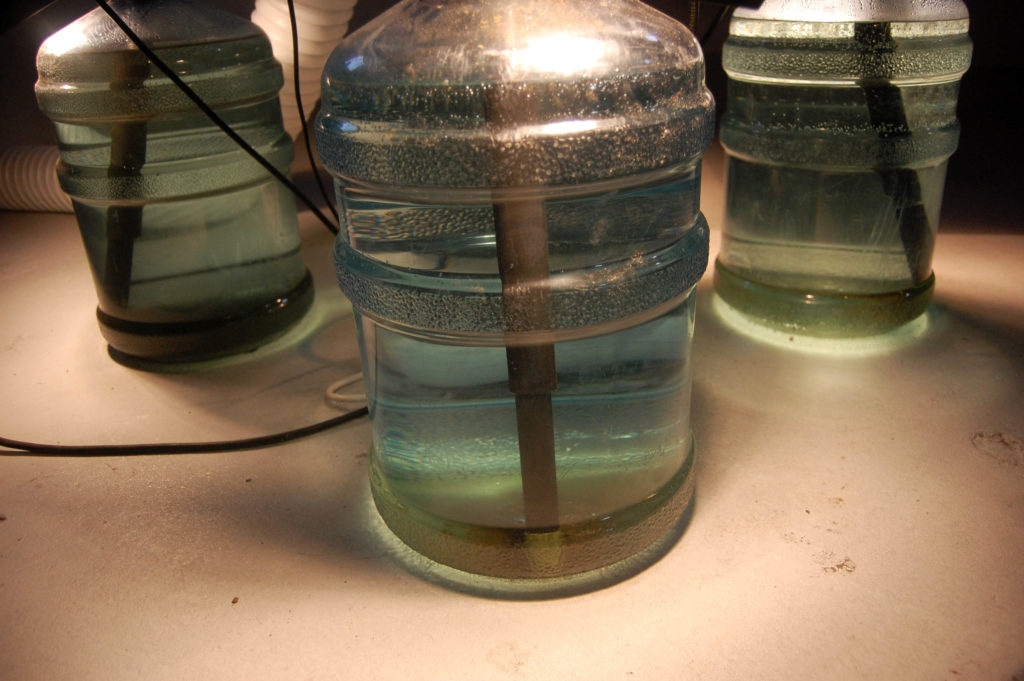
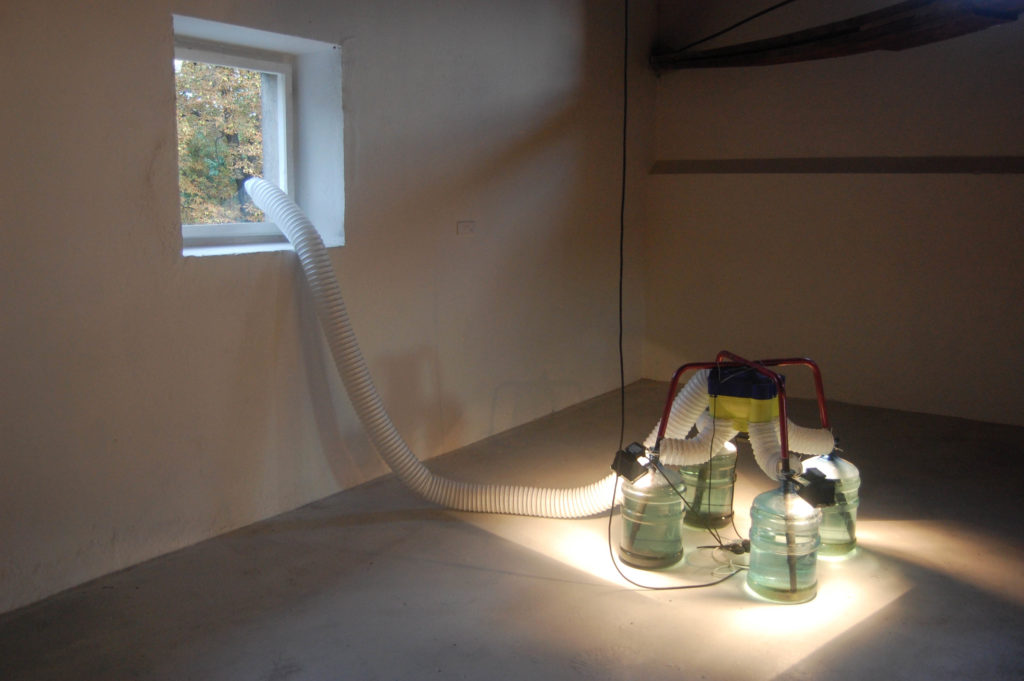
Les pièces de Rémi Bragard jouent de leur efficience et quand elles ne sous-entendent pas une rugosité, elles affirment une dangerosité (tournant sur elles-même, se dissolvant, évoquant des armes de fortune…). En travaillant avec les énergies et les forces, l’artiste exprime une sourde violence. Il convie le spectateur à tourner autour de ces objets à l’énergie contenue et qui s’avèrent être le lieu d’une pratique artistique en tension.
Rémi Bragard’s artwork plays on its performant nature, and when the art is not implied in its roughness, it asserts a certain dangerosity (self-revolving, dissolving, recalling weapons of fortune..). By working with energies and forces of nature, the artist expresses a deaf violence. He conveys the spectator to circle around these objects, whose contained energy, which in essence reveals an artistic practice in tension.
EC-101, Maribor/ Ljubljana, 15h14
Installation vidéo – Vidéo Installation, 2007
Paul Destieu (Fr)
Production : OTTO-Prod
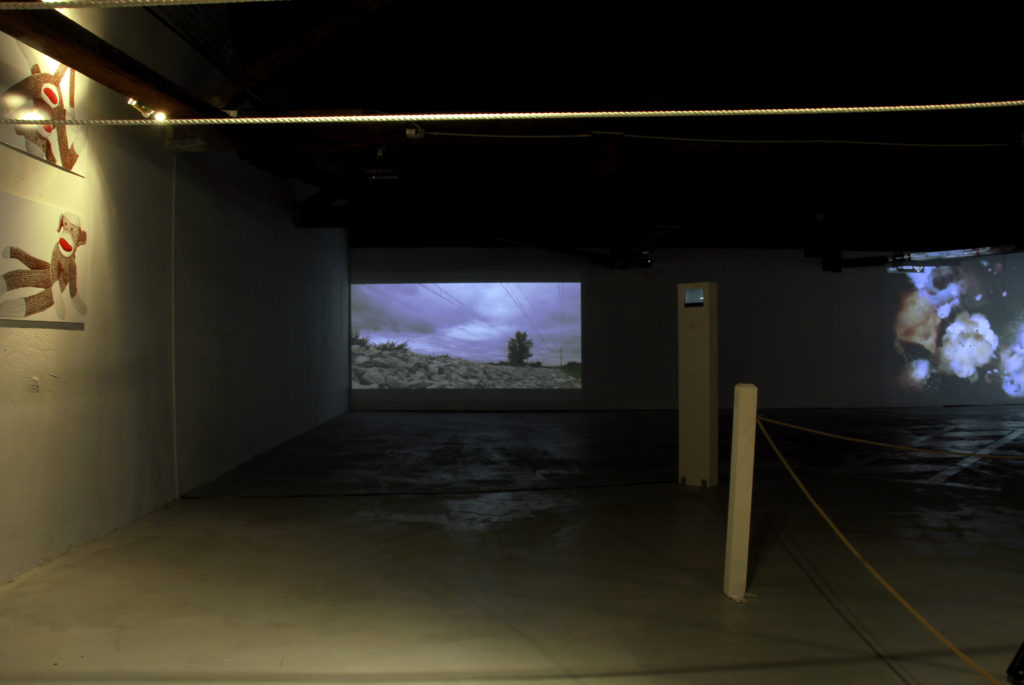
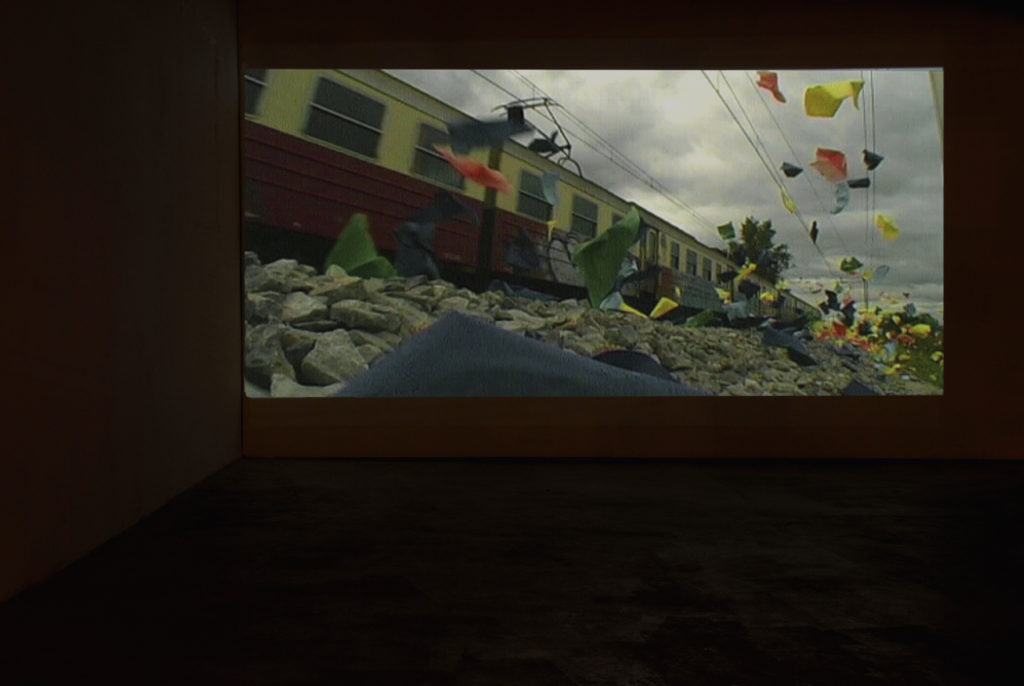
Le projet EC-101, Maribor/Ljubljana, 15h14 a été réalisé dans la campagne slovène, sur la voie ferrée qui relie la ville de Maribor à Ljubljana. Dans cette intervention – dont le titre a adopté la référence et l’horaire des trains pris pour cible – un dégradé de centaines de serviettes en papier a été échelonné sur une distance de cent mètres pour déclencher une explosion de couleur lors du passage des trains.
The project EC-101, Maribor/Ljubljana, 15h14 was shot in the countryside of Slovenia by the rail-track joining cities of Maribor to Ljubljana. In this happening entitled with the reference and the timetable of the targeted train : EC-101, a shade of napkins has been set over one hundred meters along the railway to create a colorfull attack suddenly triggered by the crossing of trains.
Afná – Afna
Dyptique de dessins à la souris – Diptych computer mouse drawing – 100 x 64 cm, 2007
Ivan Dvoršak (Slo)
Production : OTTO-Prod
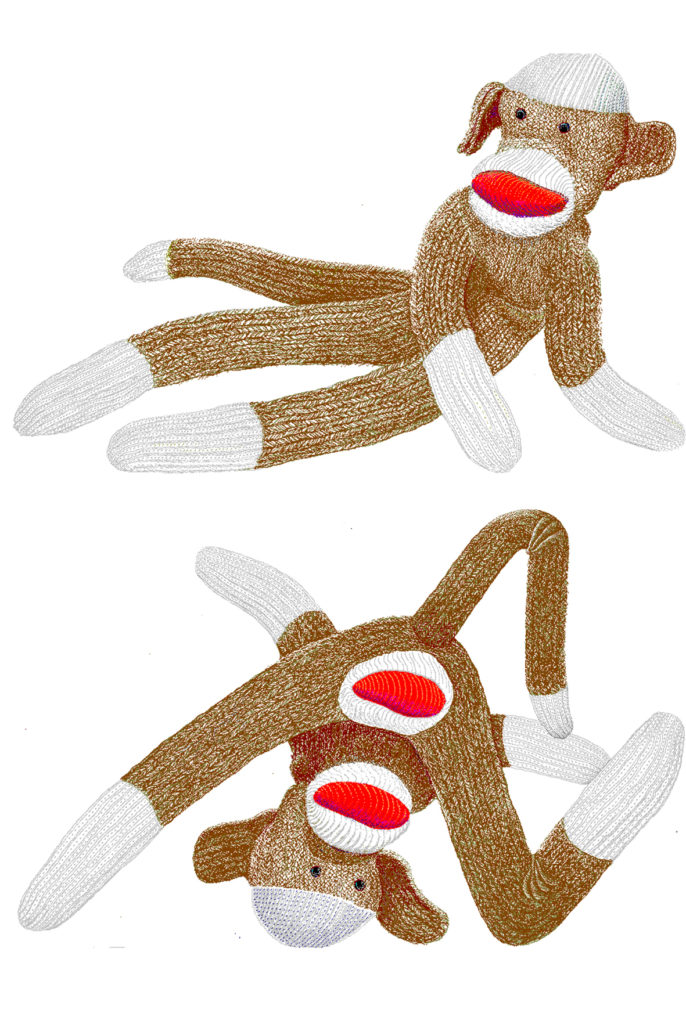
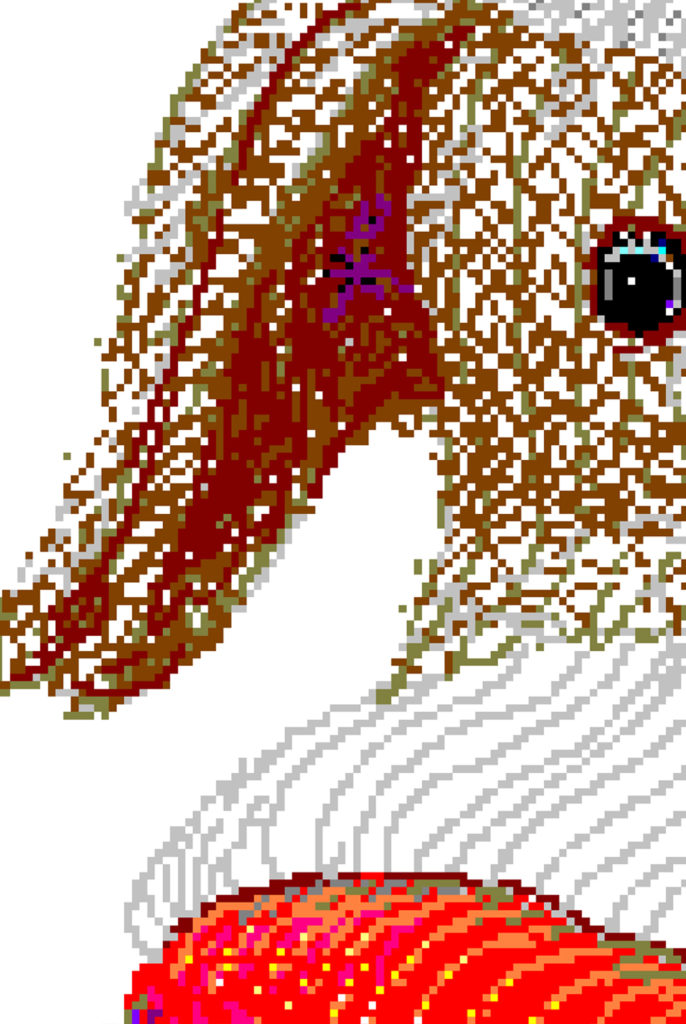
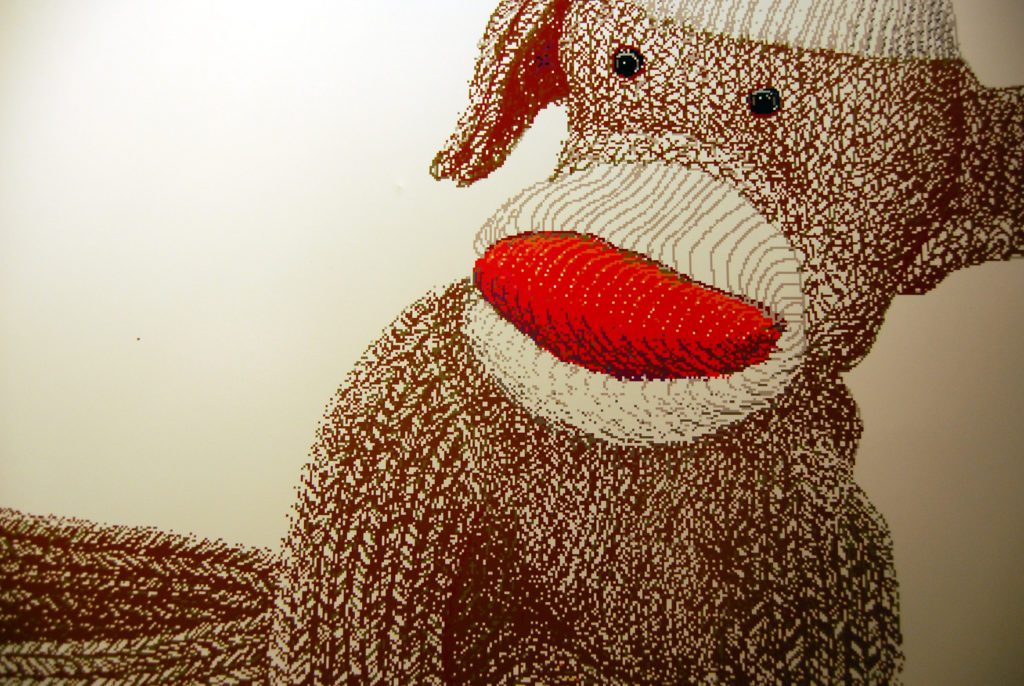
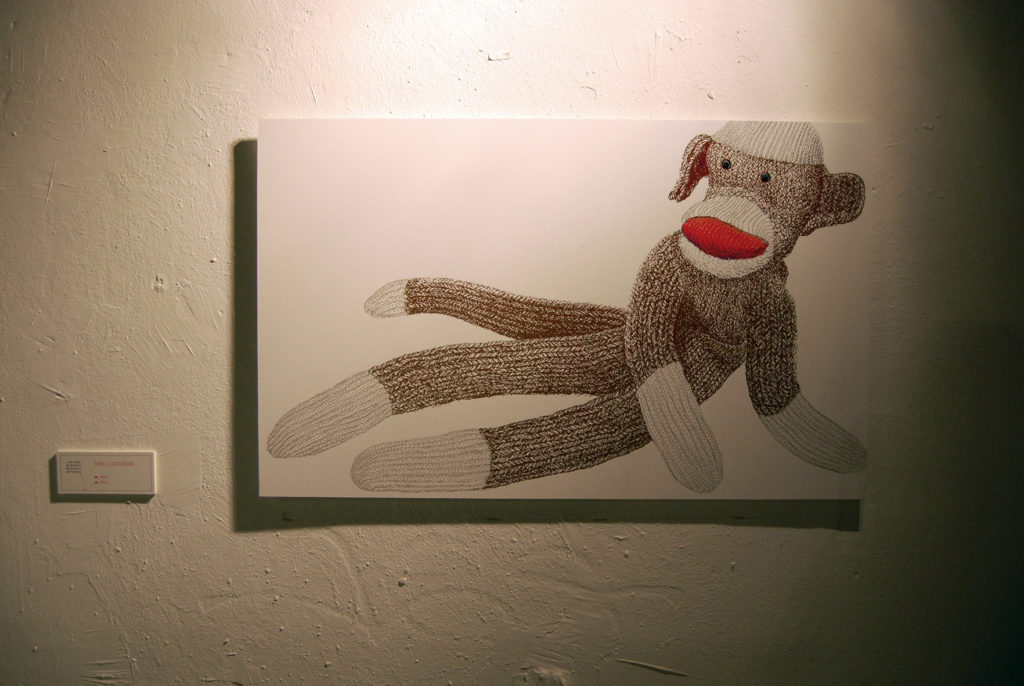
Ivan Dvoršak (1934–2013) fut l’un des photographes slovènes les plus éminents de la seconde moitié du XXe siècle, ainsi qu’un graphiste renommé. Son œuvre a exercé une influence notable sur le paysage des arts visuels slovène et yougoslave, et ses photographies des années 1970 sont à la hauteur des tendances artistiques mondiales de son époque.
Ivan Dvoršak (1934–2013) was one of the most prominent Slovene photographers from the second half of the 20th century and a renowned graphic designer. His work visibly influenced the Slovenian and Yugoslav visual art space and his photography from the 1970s are on par with contemporary world trends of his time.
While gazing at the city
Installation vidéo à deux canaux – Two-channel video installation, 2006
Polonca Lovšin (Slo)
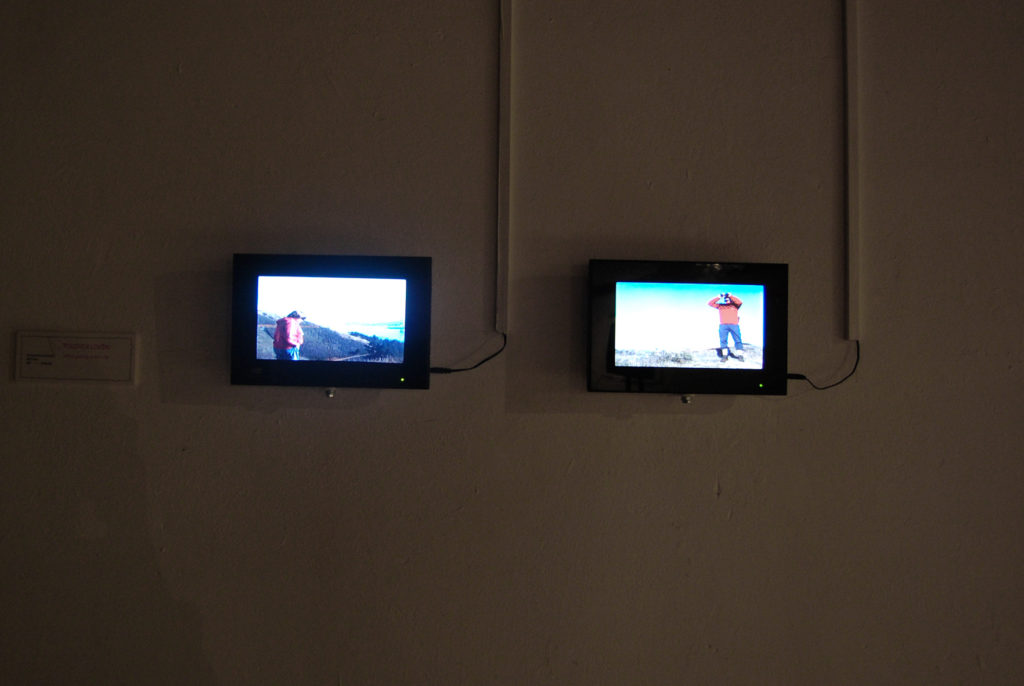
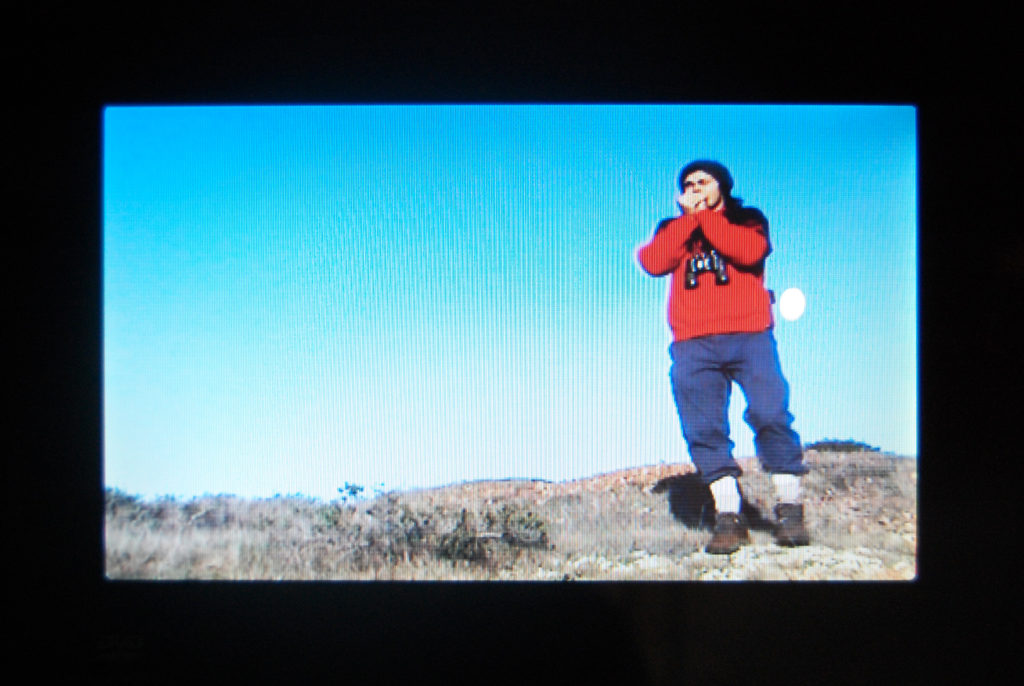
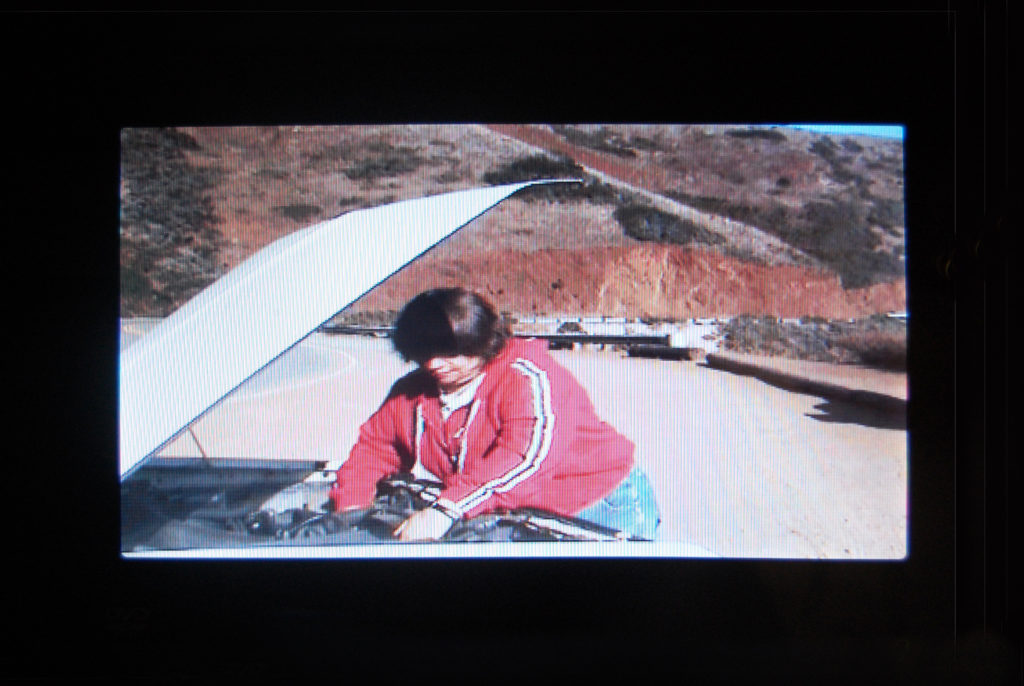
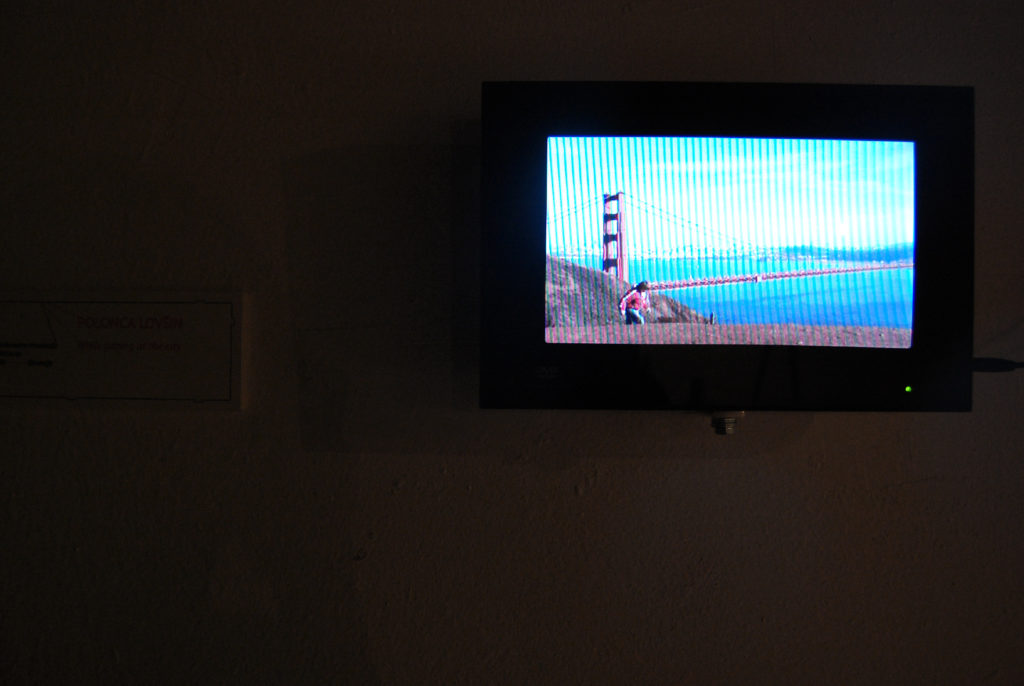
Polonca Lovšin est architecte et artiste contemporaine. À travers divers projets, elle explore des solutions individuelles s’inscrivant dans une approche DIY. Ses projets artistiques prennent la forme d’une série de solutions pratiques et inventives – à la fois high-tech et low-tech, mais toujours fonctionnelles – et abordent principalement des questions d’auto-organisation et d’autosuffisance.
Polonca Lovšin is an architect and contemporary artist. Through various projects she explores individual solutions close to DIY logics. Her artistic projects appears as a series of inventive practical solutions – high and low tech, but always functional objects – and deal mainly with questions of self-organization and self-sufficiency.
Paysage champêtre
Maquette – Model, 328 x 96 cm, 2007
Antoine Milian (Fr)
Production : OTTO-Prod
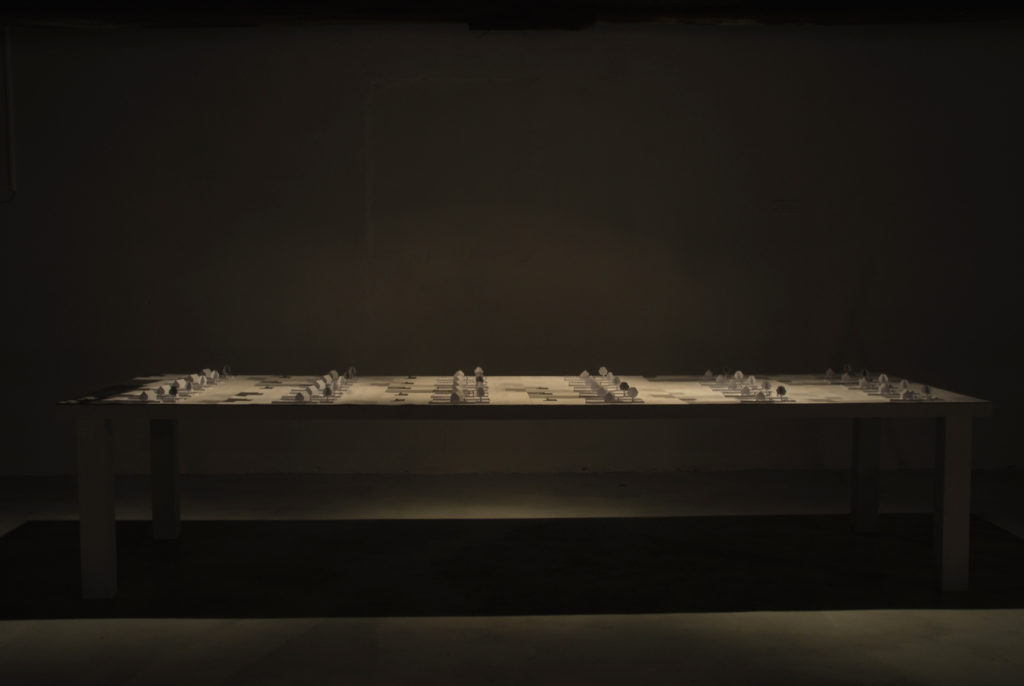
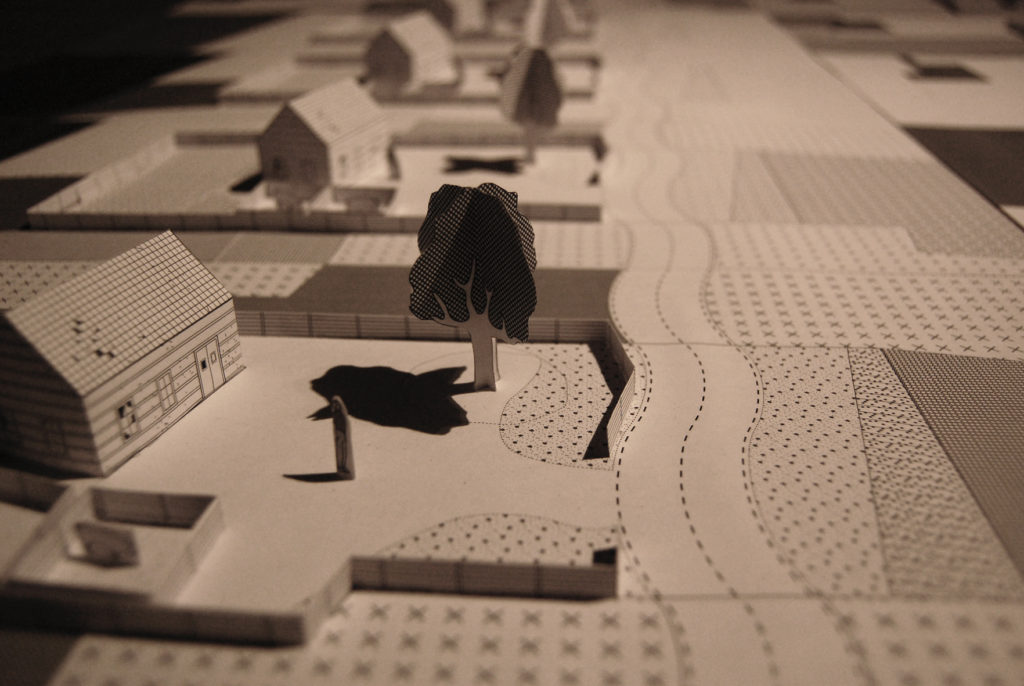
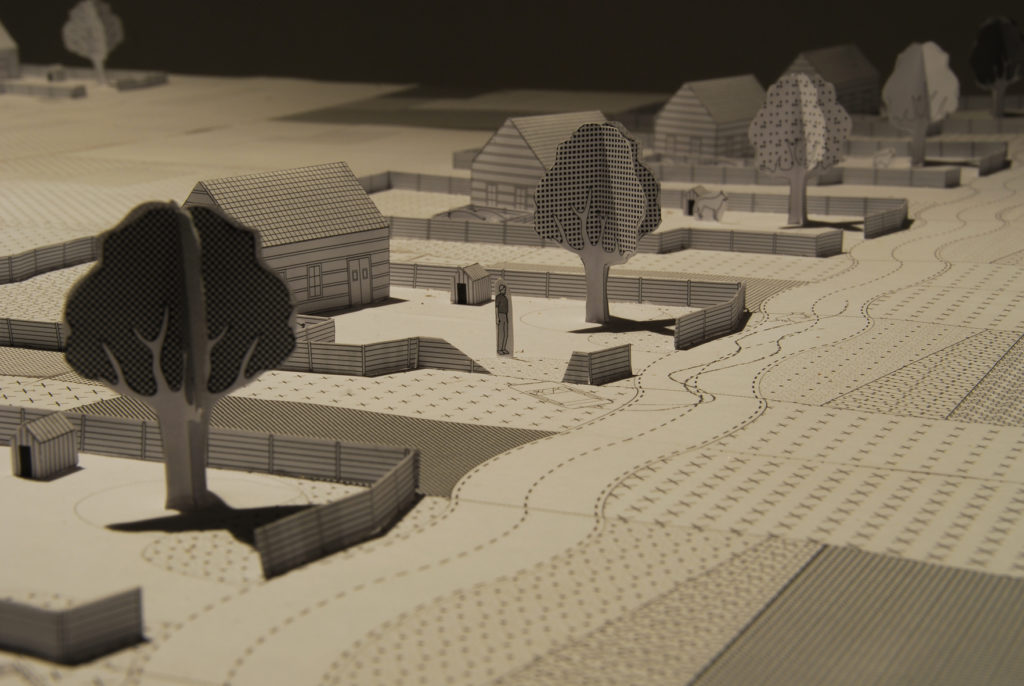
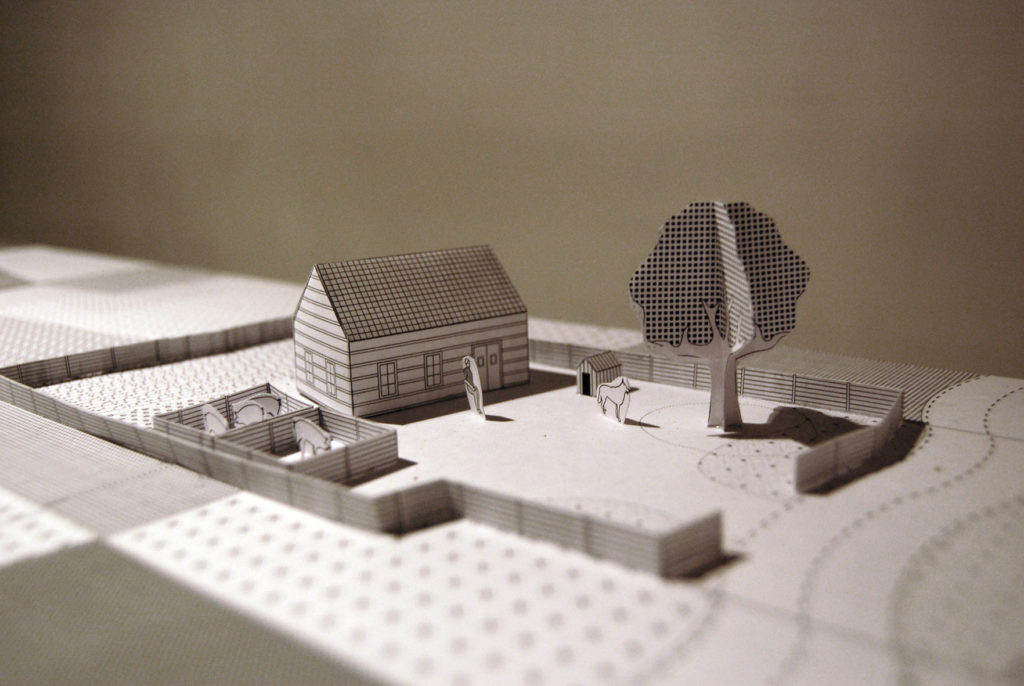
L’Occident a sacrifié ses religions sur l’autel du progrès – Dieu est mort. Pourtant, la foi n’a pas totalement disparu. Antoine Milian illustre ce basculement en créant de nouveaux systèmes de croyance : un culte froid et matériel nommé Mythologie standardisée, qui exprime les émanations spirituelles du monde post-industriel. Il y synthétise une civilisation complexe, régulée par d’infinis flux d’information et de communication.
The West sacrificed its religions on the altar of progress – God is dead. Yet faith persists in new forms. Antoine Milian captures this shift by inventing belief systems for a post-industrial world: a cold, material cult he calls ‘Standardized Mythology’. He distills the complexity of civilization as a self-regulating organism, structured by infinite networks of information and communication.
Venice Prome Time (Family)
Tirage photographique, couleur – Color photographic print,100x130cm, 2007
Luce Moreau (Fr)
Production : OTTO-Prod
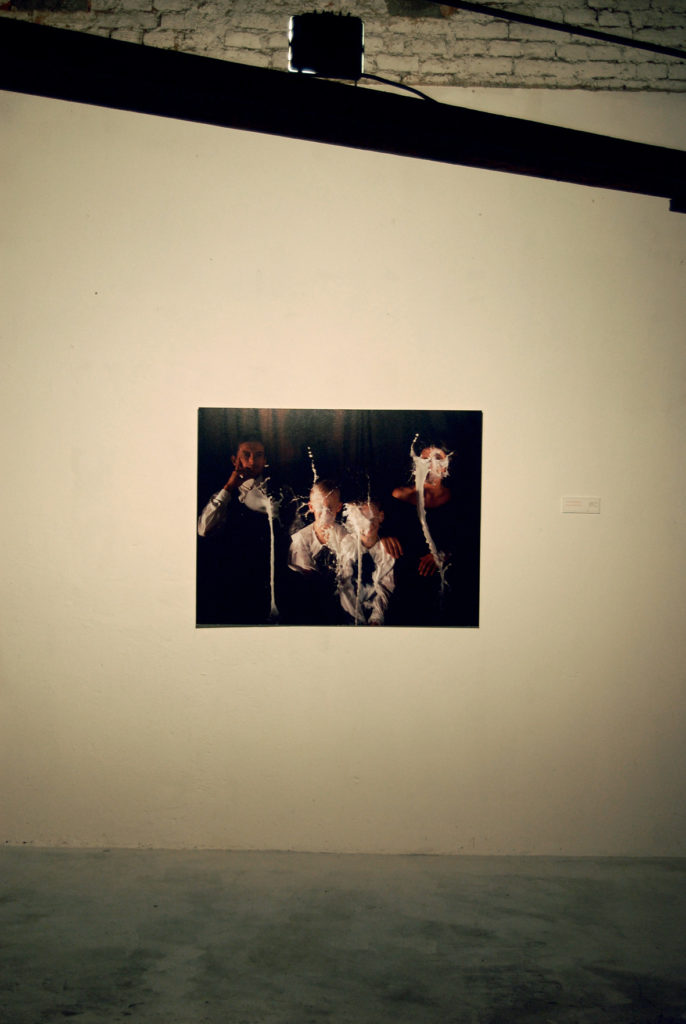
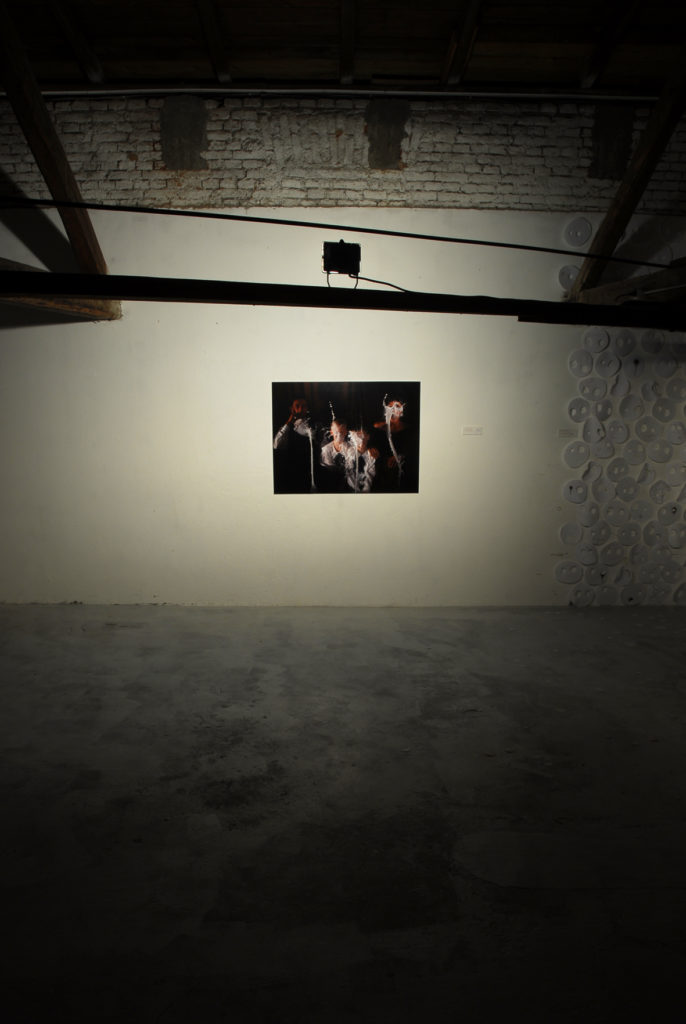
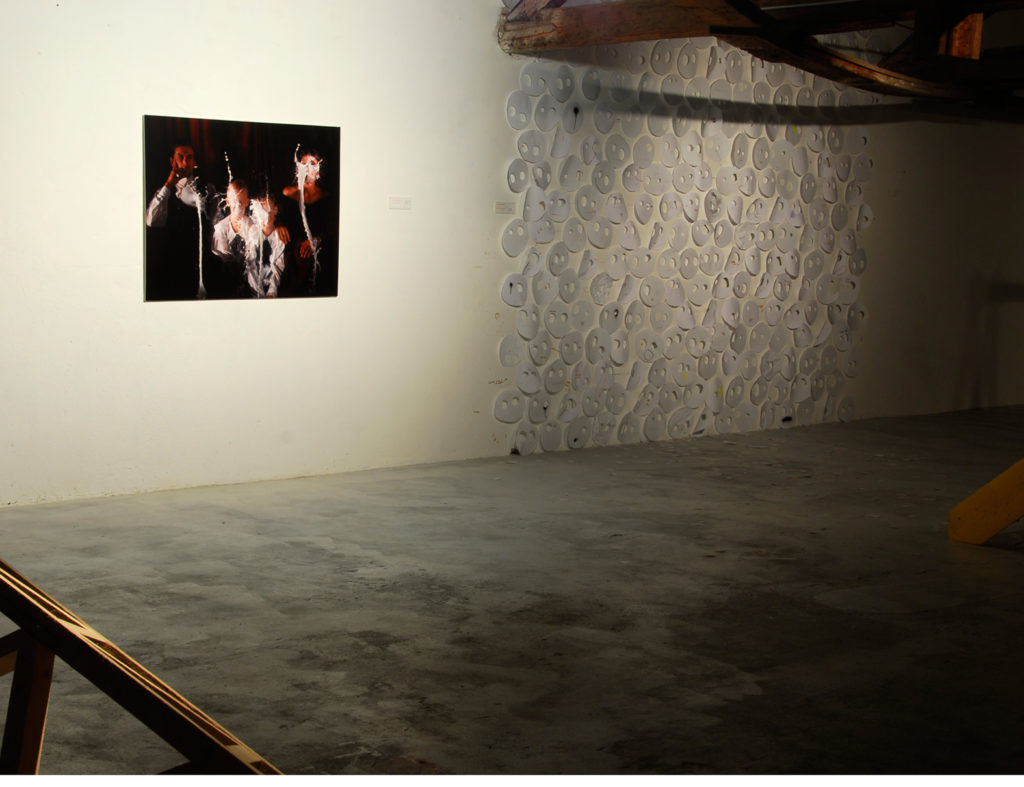
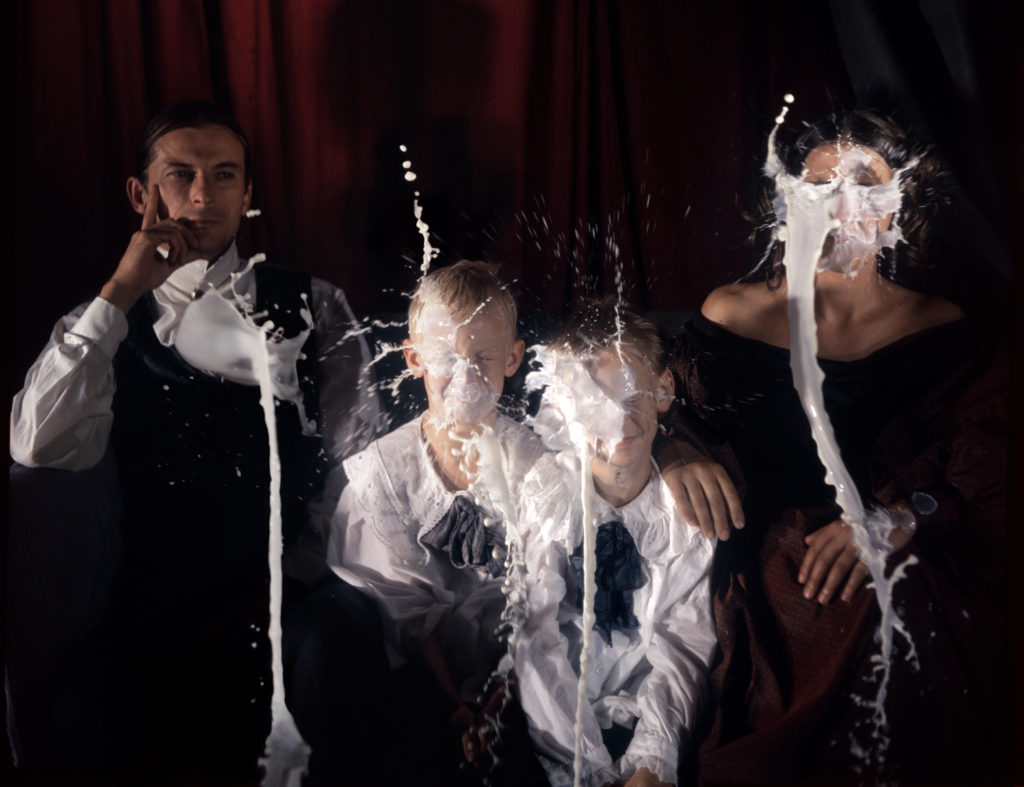
Les projets photographiques de Luce Moreau servent de prétextes à la mise en scène d’événements et d’expériences. En recrutant ses modèles via des appels publics, elle interroge la notion de « casting ». Son travail flirte avec le théâtre, en intégrant décors et acteurs : artificialité, répétition, contrôle de soi. Dans Venice Prome Time, elle s’inspire de la tradition du portrait mondain pour en détourner les codes et en révéler les enjeux sociaux, ces représentations visant souvent à figer le modèle dans une forme d’éternité.
Luce Moreau’s photographic projects serve as pretexts for orchestrating events and experiences. By inviting models through public media calls, she investigates the concept of « casting. » Her work leans toward theatricality, incorporating staging and actors: artificiality, repetition, and self-discipline. In Venice Prome Time, she draws inspiration from the tradition of high-society portraiture, using it to satirize the social dynamics behind such images -portraits that typically aim to grant the subject a sense of timelessness.
La Scène – L’Audience
Techniques mixtes – Mixed media, 350 x 350 x 350cm, 2007
Olivier Morvan (Fr)
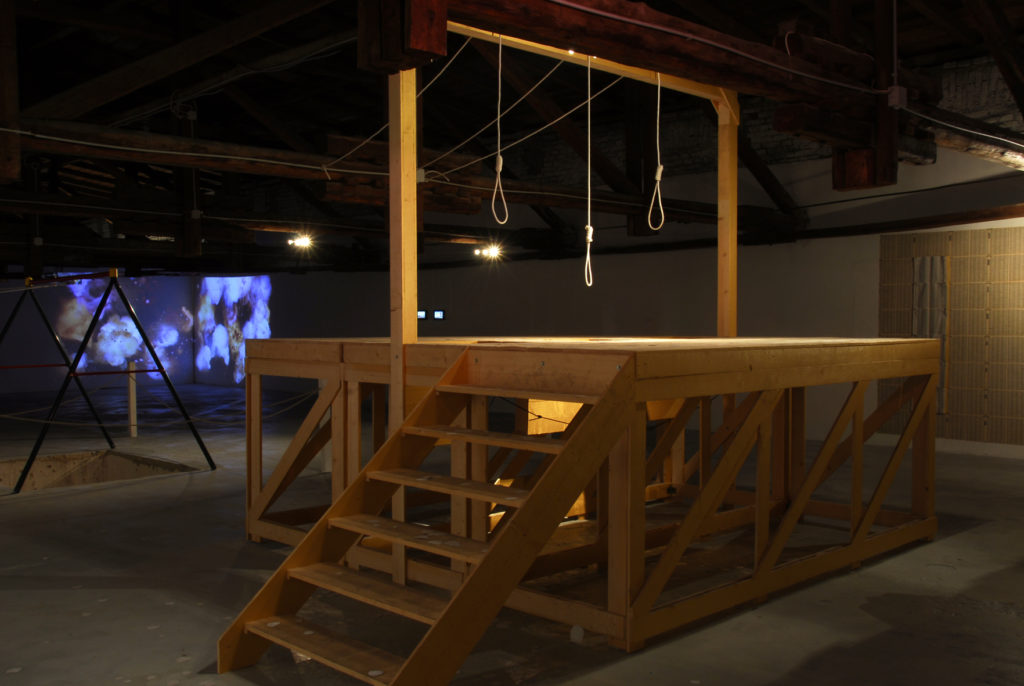
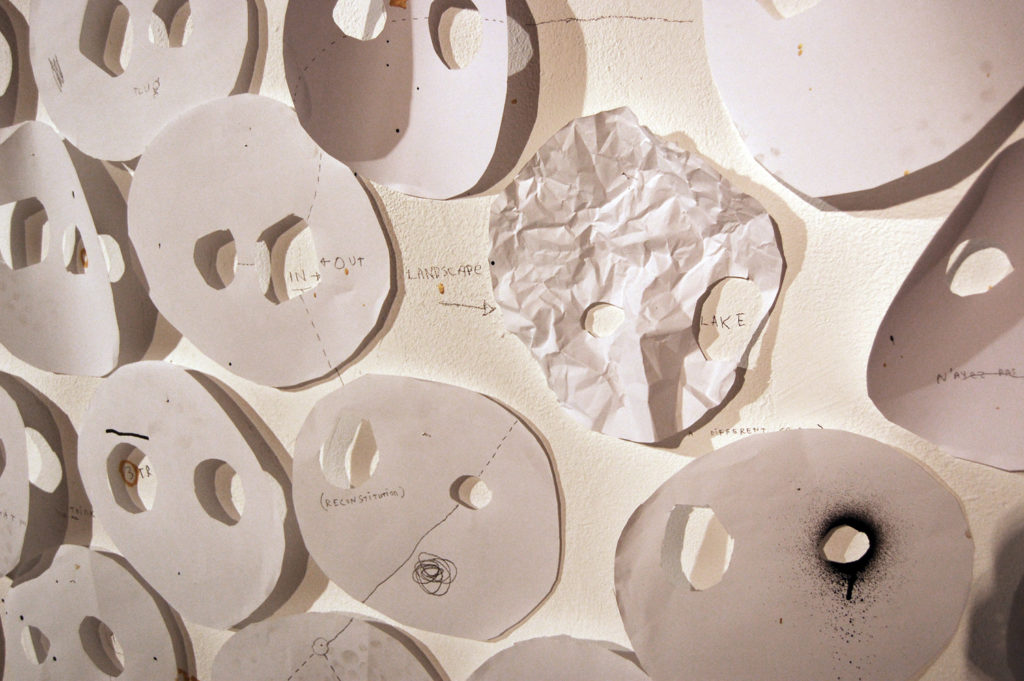
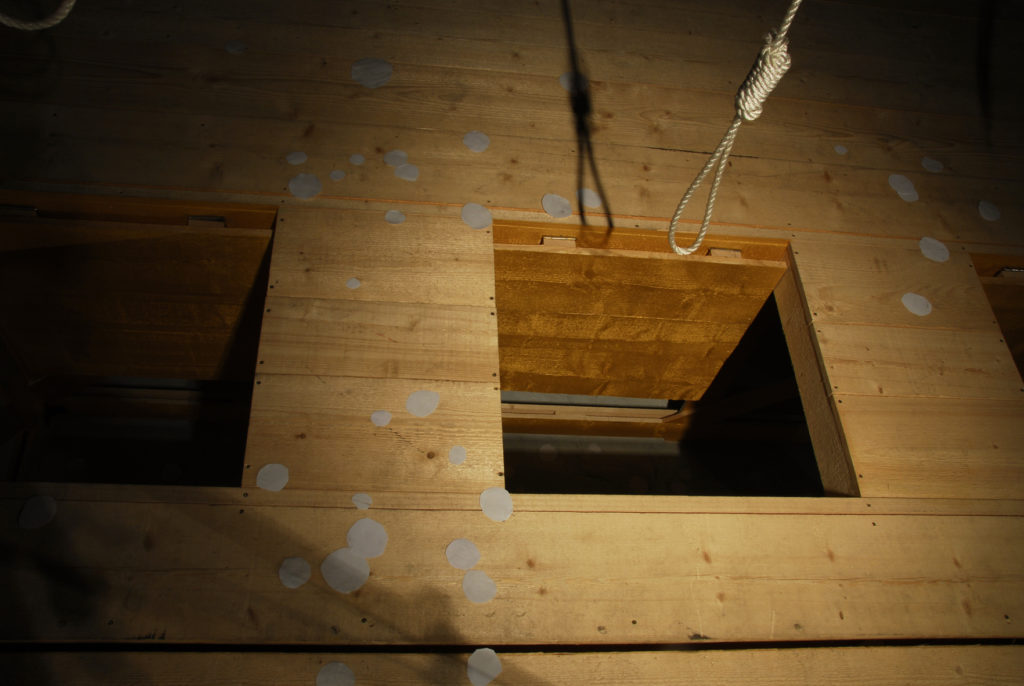
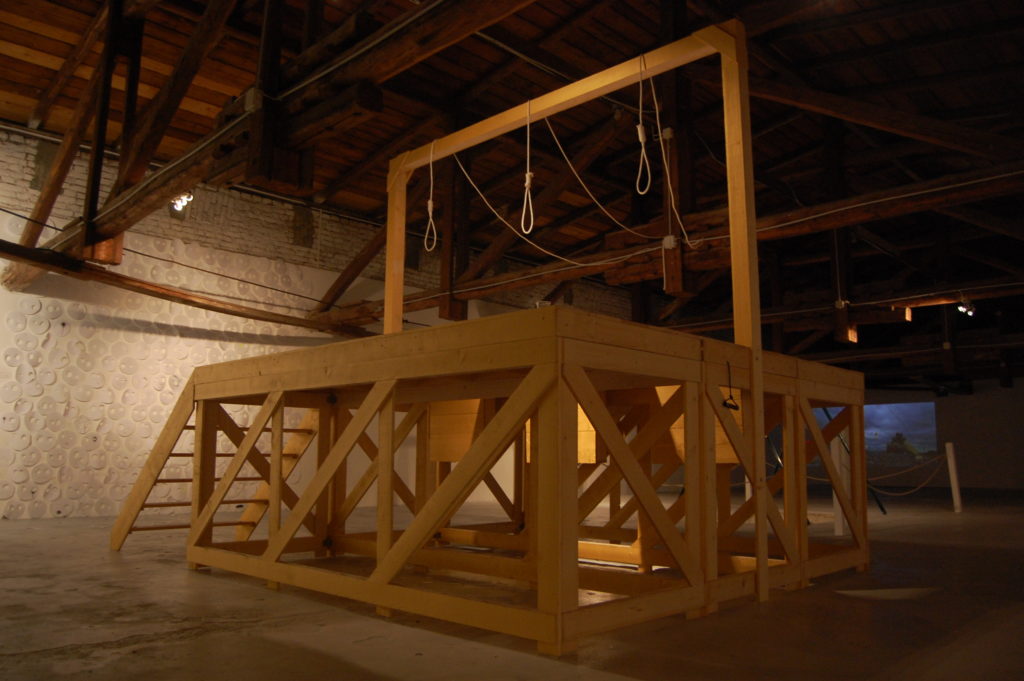
L’enquête est au point mort. Nous interceptons des messages cryptés. Personne ne sait ce que nous cherchons. Nous disposons de plusieurs indices, mais ils se contredisent. Trois suspects masqués se sont échappés par ce tunnel creusé sous la maison, qui traverse la frontière. Les reconstitutions nous mènent sur des pistes qui n’aboutissent à rien, tandis que l’opinion publique se tend. Allons-nous devoir fabriquer des preuves ?
The investigation is at a standstill. We are intercepting encrypted messages. No one knows what we are looking for. We are holding several clues, but they contradict each other. Three masked suspects escaped through this tunnel dug under the house, which crosses the border. The reconstructions are leading us down paths that go nowhere, while the public grows increasingly worried. Are we going to have to fabricate evidence?
… Therefore I am
Assemblage de bottins téléphoniques – Assemblage of Phone Books, 240 x 600 cm, 2007
Patrik Ševčík (Sk)
Production : OTTO-Prod
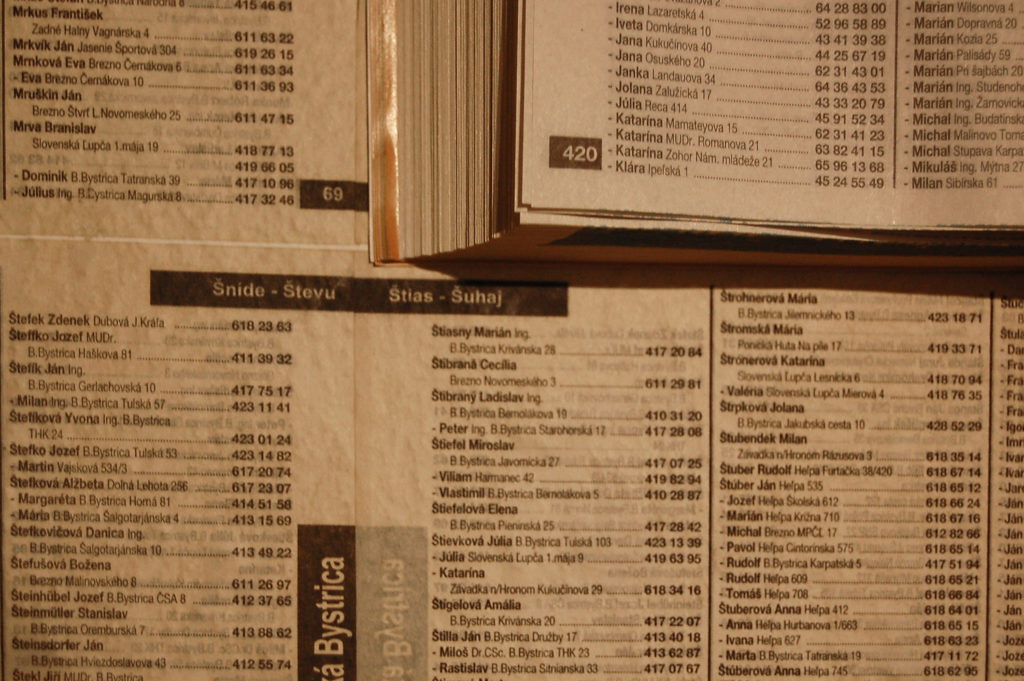
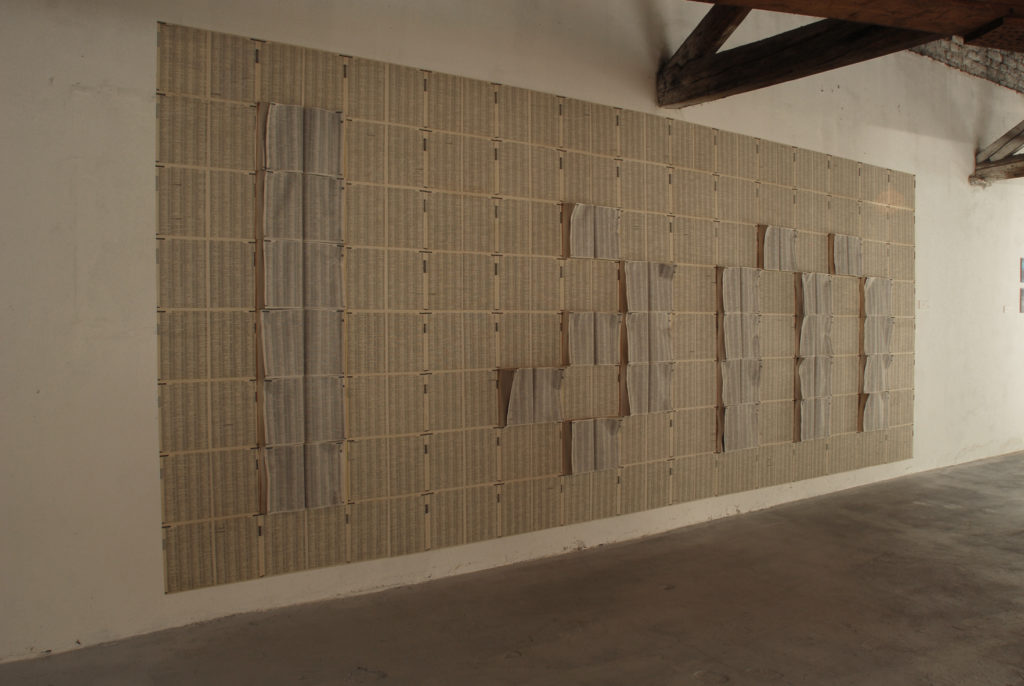
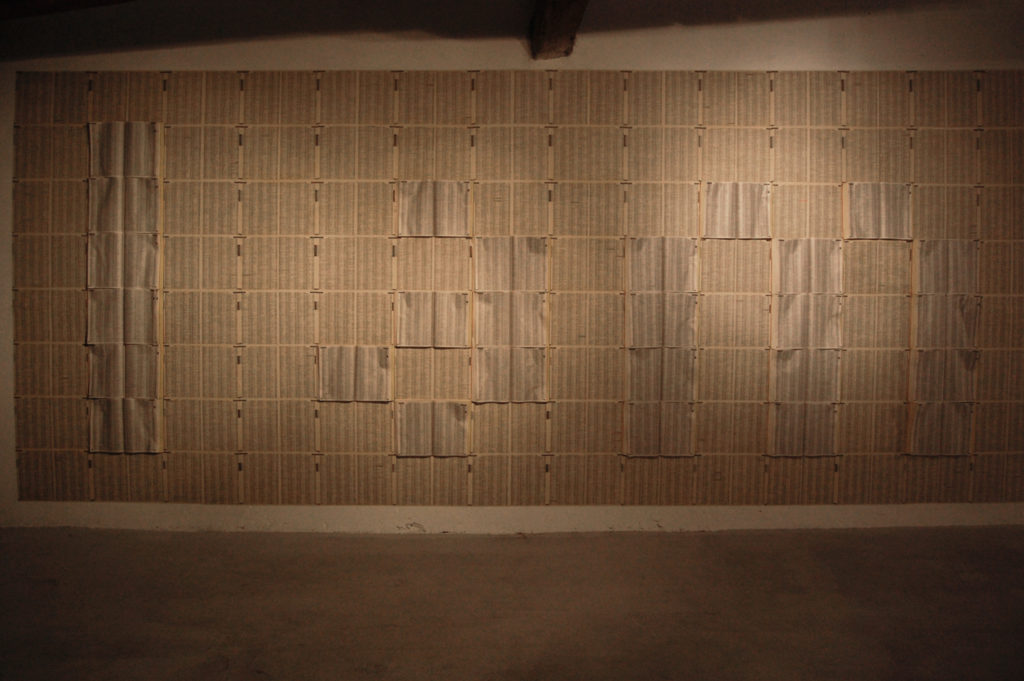
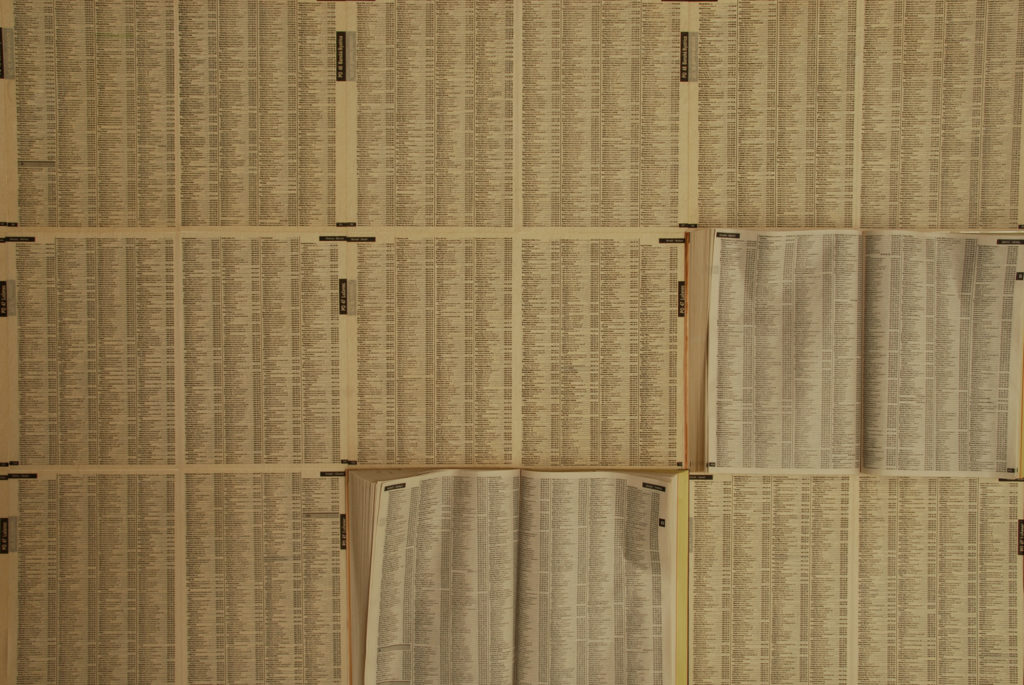
À travers sa pratique, Patrik Ševčík engage un dialogue avec les préoccupations politiques et sociales contemporaines. Usant de stratégies conceptuelles et post-conceptuelles, il crée une forme de travail intangible, médiée par le texte – Expressions qu’il déconstruit, efface, libère ou rend volontairement illisibles, mettant en évidence les éléments et phénomènes qui composent notre environnement contemporain.
Through his practice, Patrik Ševčík engages in a dialogue with contemporary political and social concerns. Using conceptual and post-conceptual strategies, he creates an intangible form of work mediated by text — expressions that he deconstructs, erases, releases, or deliberately renders unreadable, highlighting the elements and phenomena that shape our contemporary environment.
Salamander
Installation vidéo à deux canaux – Two-channel video installation, 2006
Pascual Sisto (Us)
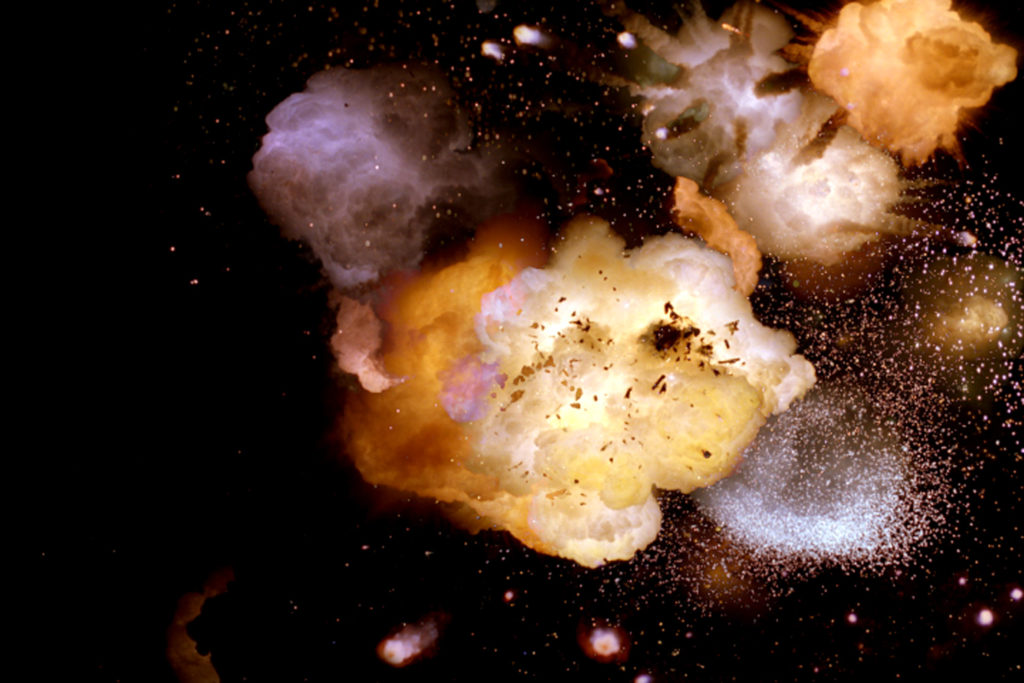
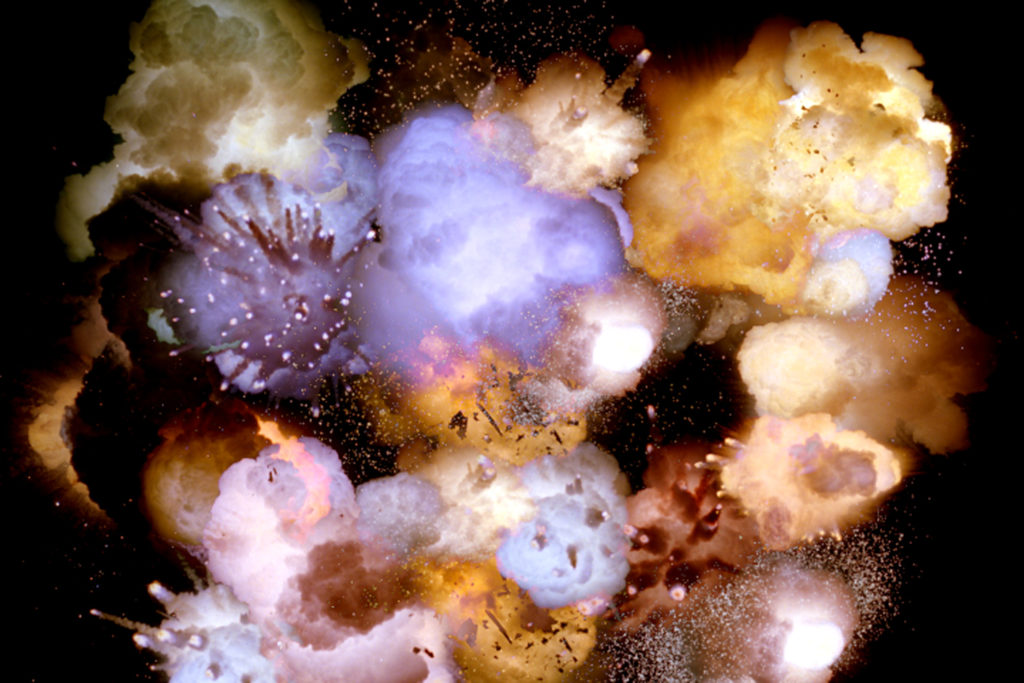
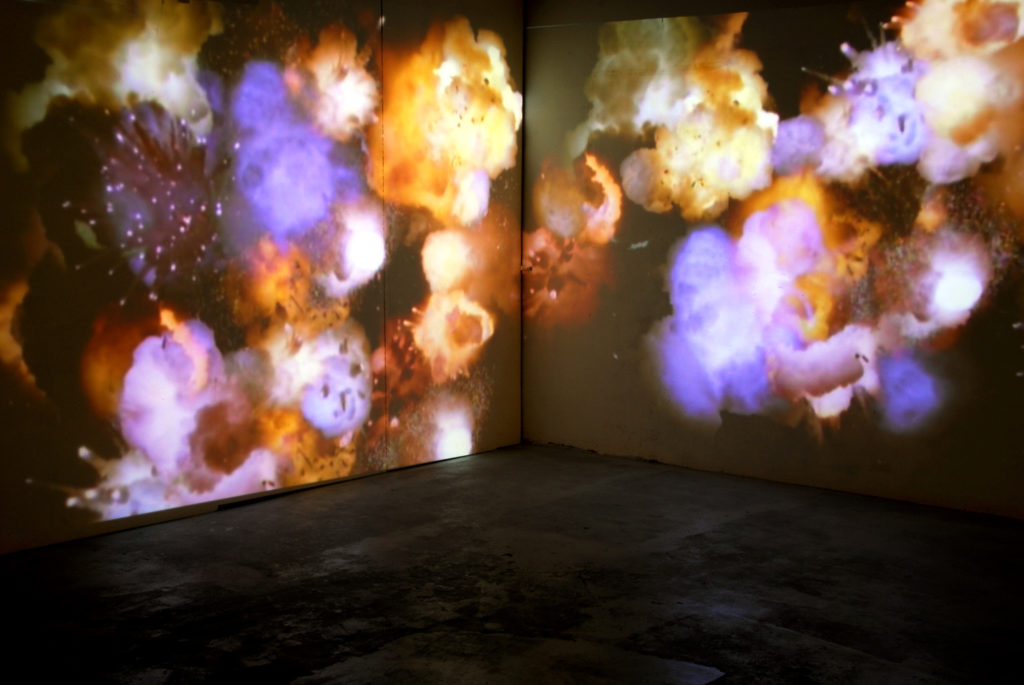
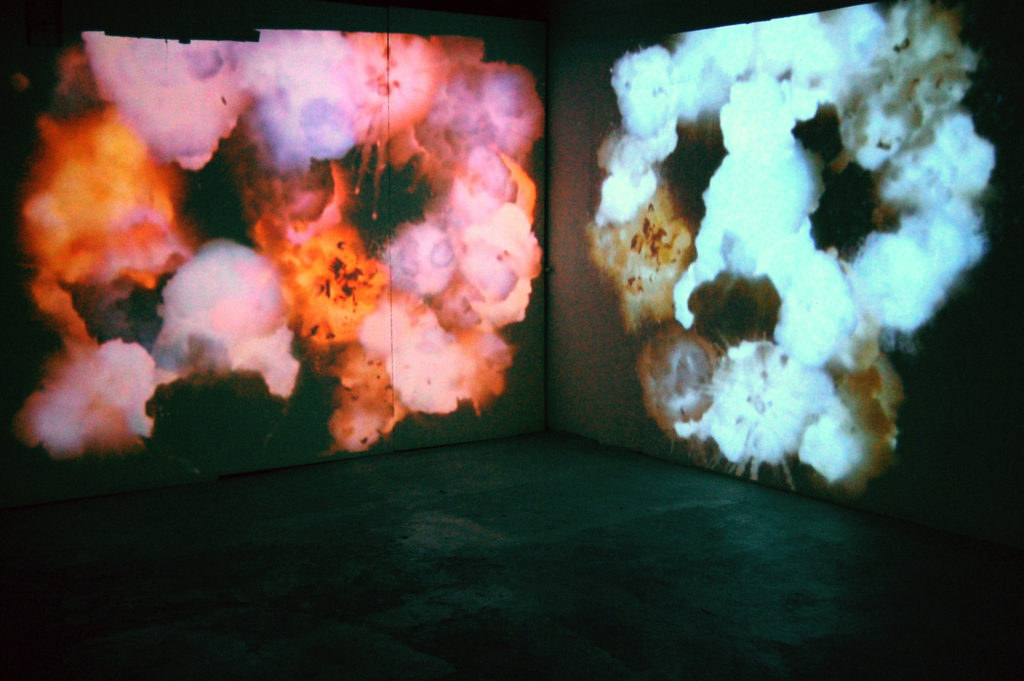
« Salamander » (2006) est une installation vidéo multi-canaux composée de séquences d’explosions tirées de banques d’images, aux couleurs vives et saturées, que Sisto qualifie de « ready-mades numériques ». Sa cacophonie explosive se mue peu à peu en une rumeur sourde, presque ondoyante, et l’effet hypnotique d’un écran mural saturé de lumière et de couleur devient une expérience à la fois sensorielle, envoûtante et cathartique.
“Salamander” (2006) is a multi-channel video collage featuring high-res, lushly hued and sumptuously filmed stock footage explosions which Sisto describes as “digital ready-mades”. Its dissonant symphony of loud explosions resolves itself into a dull almost tidal lullaby soon enough, and the hypnotic effect of a wall-size screen literally bursting with light and color is decadent, addictive and cathartic.
Da/Ne (Yes/No)
Tableau et craie – Blackboard and chalk, 60 x 90 cm, 2007
son :DA ( Slo)
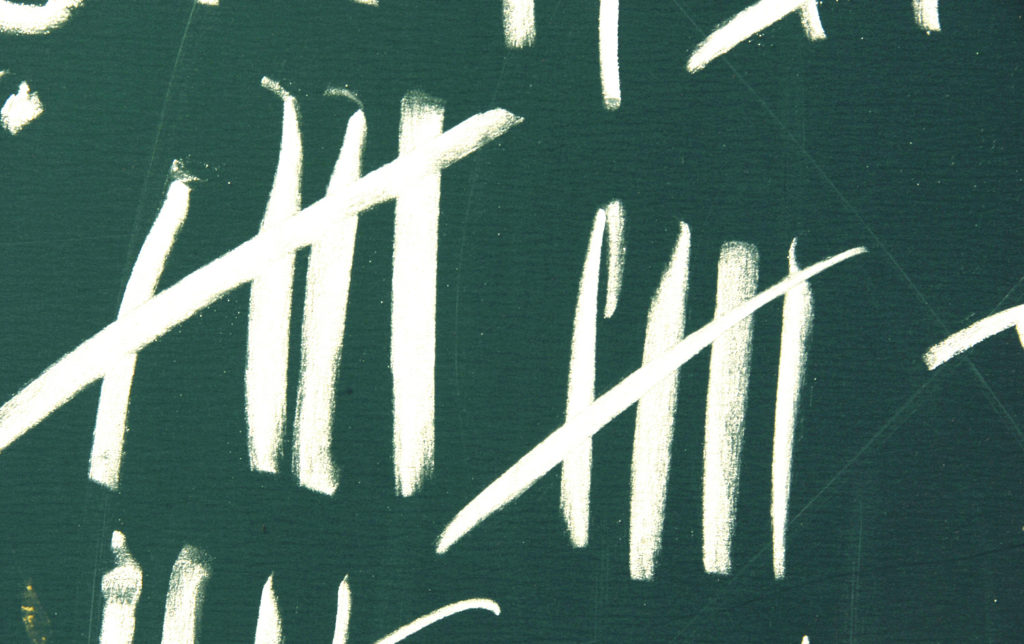
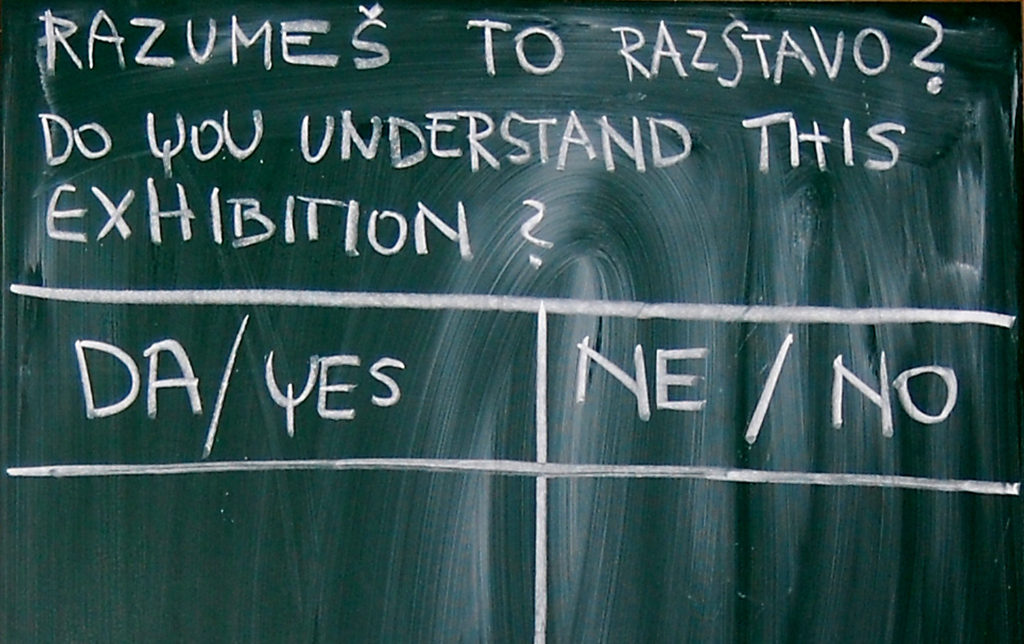
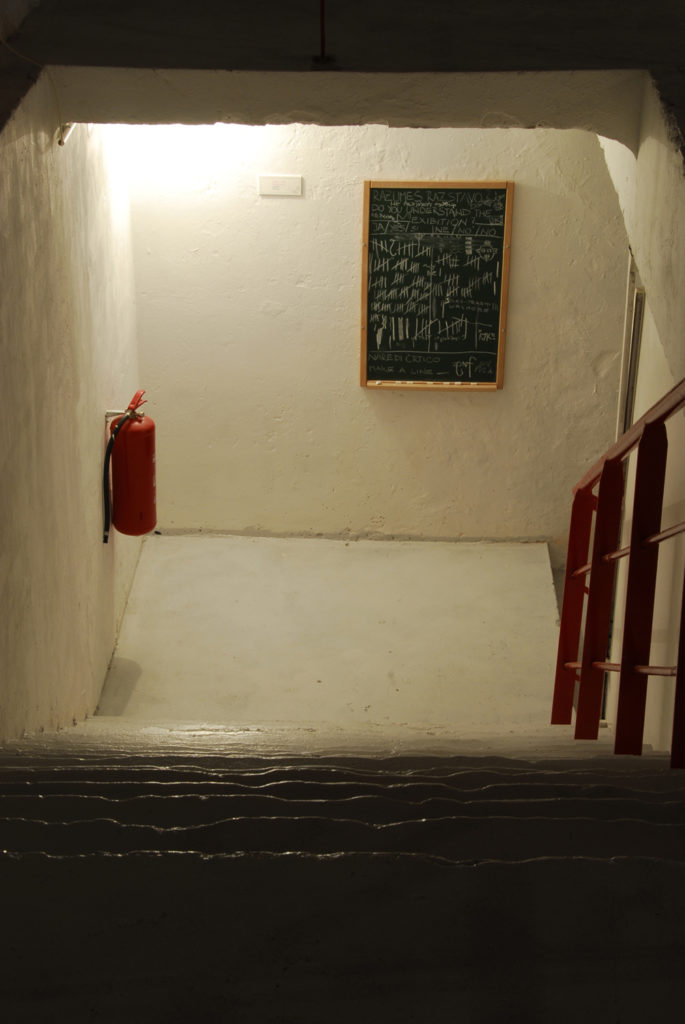
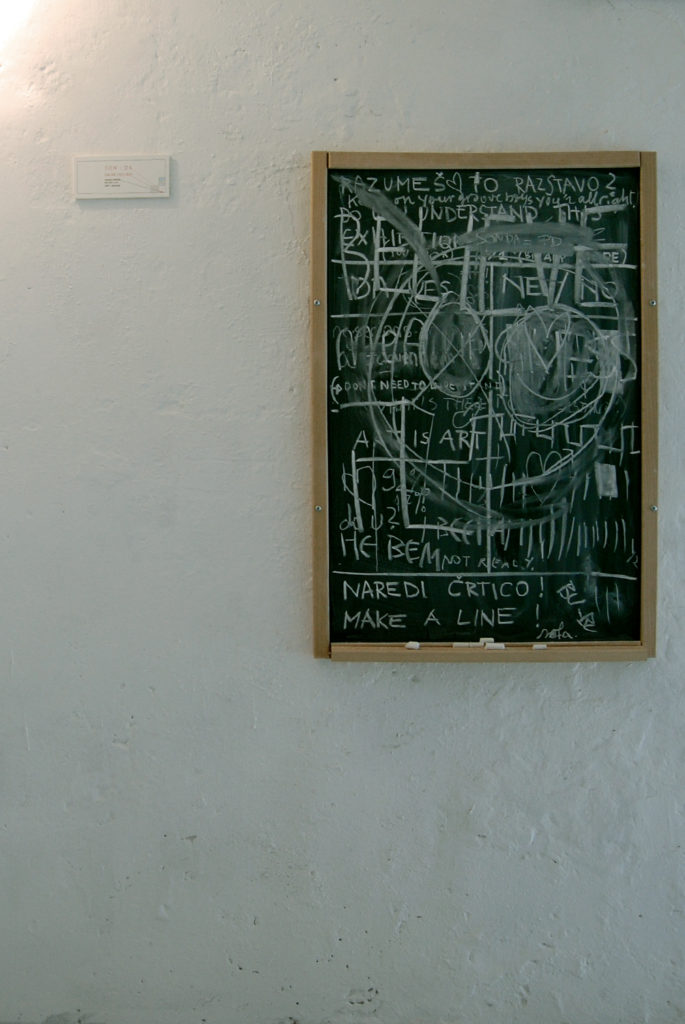
Le duo artistique son:DA (Metka Golec et Miha Horvat) appartient à une génération d’artistes marquée par la technologie numérique et le progrès technologique constant. L’utilisation des médias numériques dans l’art peut se limiter à leurs « avantages », ou, comme c’est le cas avec son:DA, à leur véritable « détournement ». L’enthousiasme pour la technologie moderne et ses possibilités infinies se traduit ici par du cynisme et de l’ironie. L’ironie née du questionnement sur l’interconnexion mondiale se manifeste à plusieurs niveaux : dessins réalisés à la souris d’ordinateur dont le contenu fait toujours référence aux gadgets électroniques, utilisation illogique des câbles et de leur valeur (in)esthétique, performances audiovisuelles low-tech, ou encore présentations humoristiques des outils de communication courants.
Artistic partnership son:DA (Metka Golec and Miha Horvat) belongs to the generation of artists, which are defined by digital technology and constant technological progress. The use of digital media in art can be limited to their ‘benefits’ or, as is the case with son:DA, to their direct ‘abuse’. Enthusiasm over modern technology and its infinite possibilities translated into cynicism and irony. The irony raised by questioning the global connectedness of the world is manifested on different levels: drawings made using a computes mouse whose content always refers to electric gadgets, illogical use of cables and their (un)aesthetic value, low tech audio-video performances or presentations of usual communication tools in a humorous way.
Sous l’O
4 tirages photographiques couleurs – 4 color photographic prints, 2007
Cathy Weyders (Be)
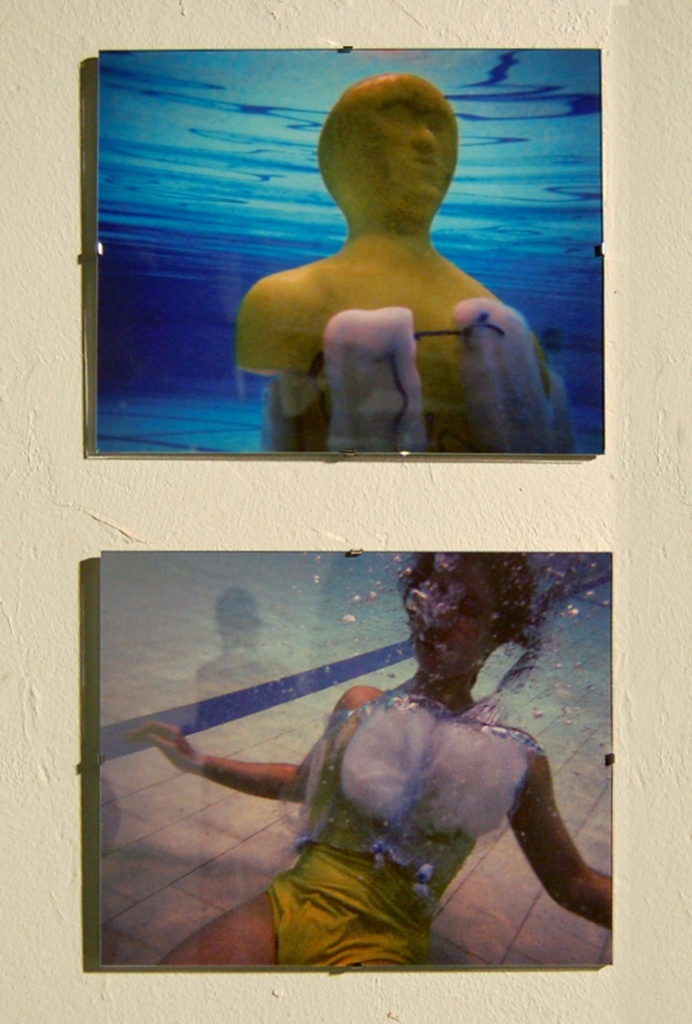
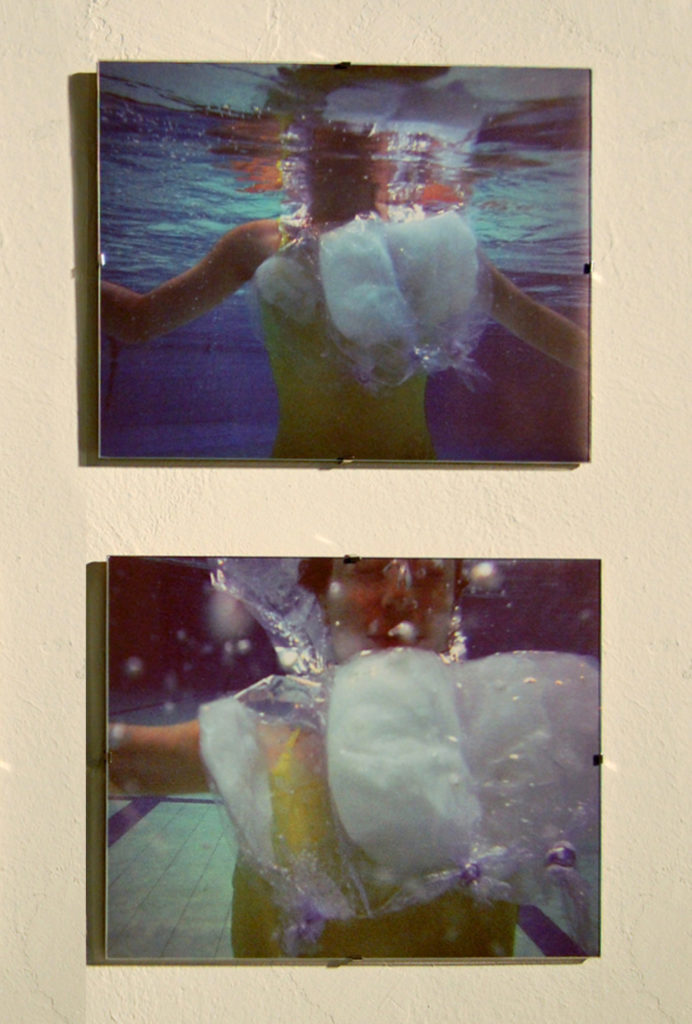
Les œuvres de Cathy Weyders prennent la forme de sculptures polymorphes et d’installations. Ces formes empruntent souvent l’apparence d’habitats organiques, évoquant des monstres, des microbes ou encore des environnements futuristes – des espaces que le public peut observer et pénétrer. Les notions de territoire, « d’architecture microbienne », d’habitat ou d’abri dessinent autant de motifs récurrents qui structurent son rapport à l’espace, tout en convoquant les concepts de confort, de protection et de fragilité.
Cathy Weyders develops her work through polymorphic sculptures and installations. These forms often borrow the appearance of organic dwellings, evoking monsters, microbes, or even futuristic environments — spaces that the audience can observe and sometimes enter. The notions of territory, “microbe architecture,” lodging, and shelter define recurring patterns that shape her relationship with space, while simultaneously questioning concepts of comfort, protection, and fragility.
La rupture
Ossature bois – Wood structure, 32 x 32 x 800cm, 2007
Colson Wood (Fr)
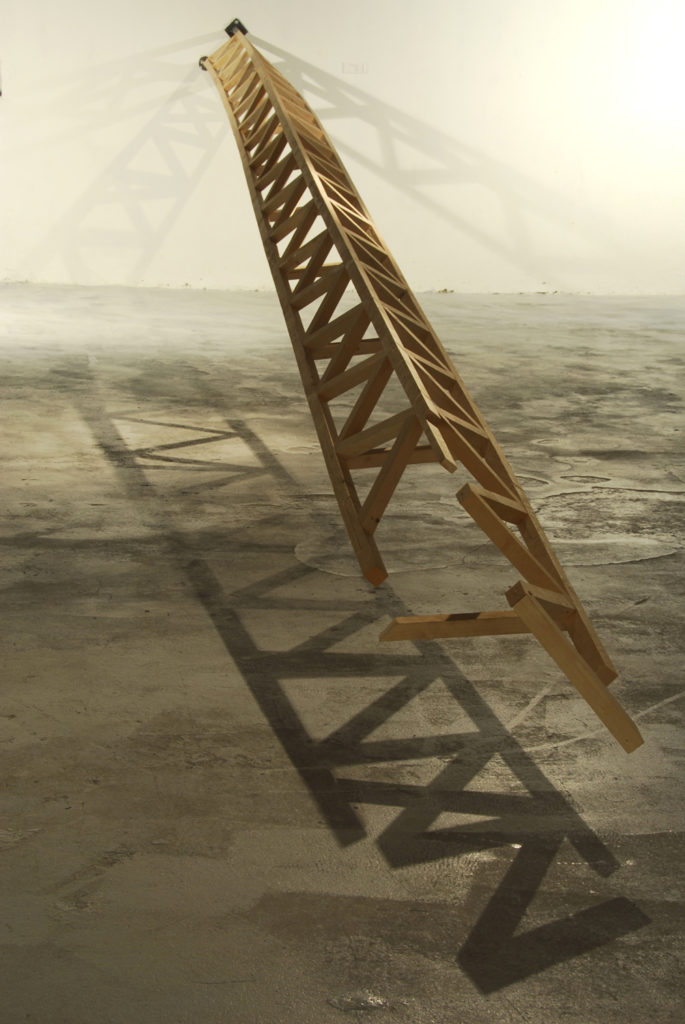
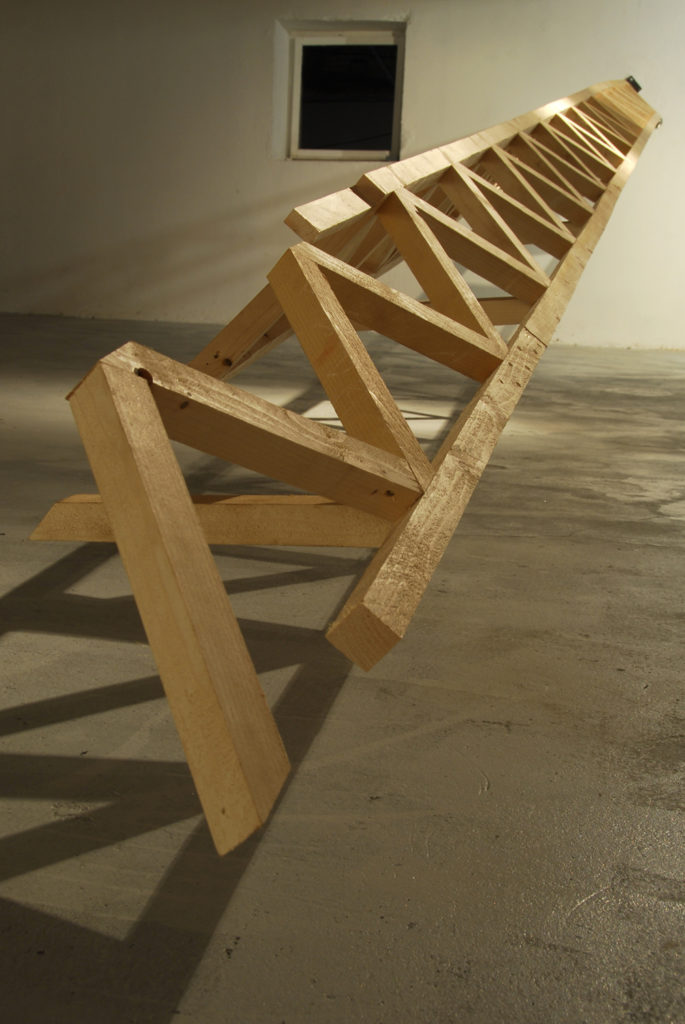
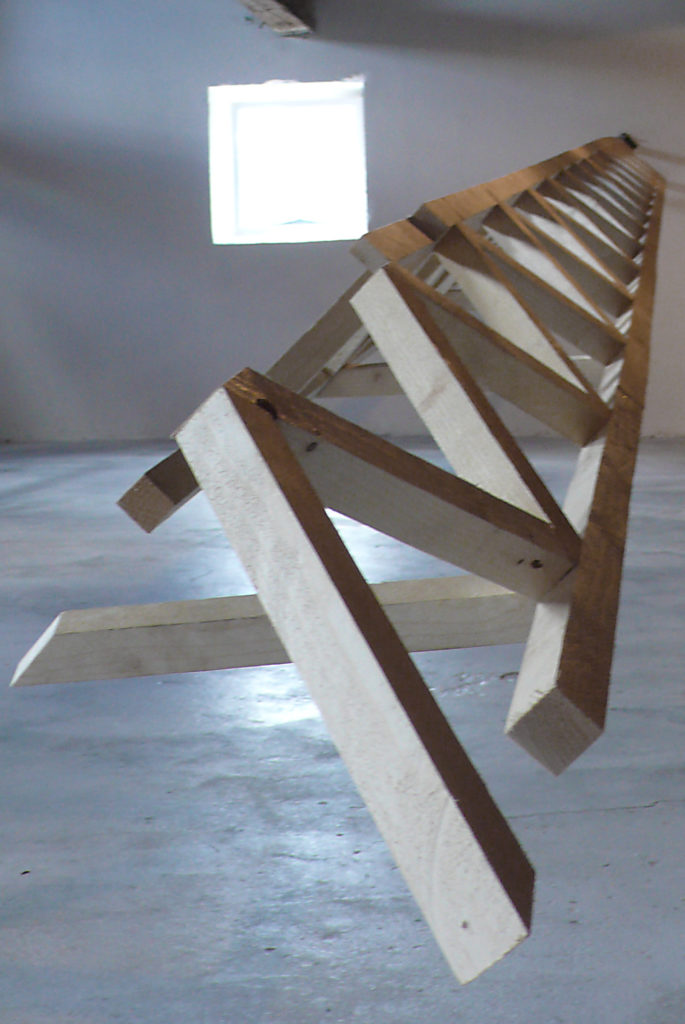
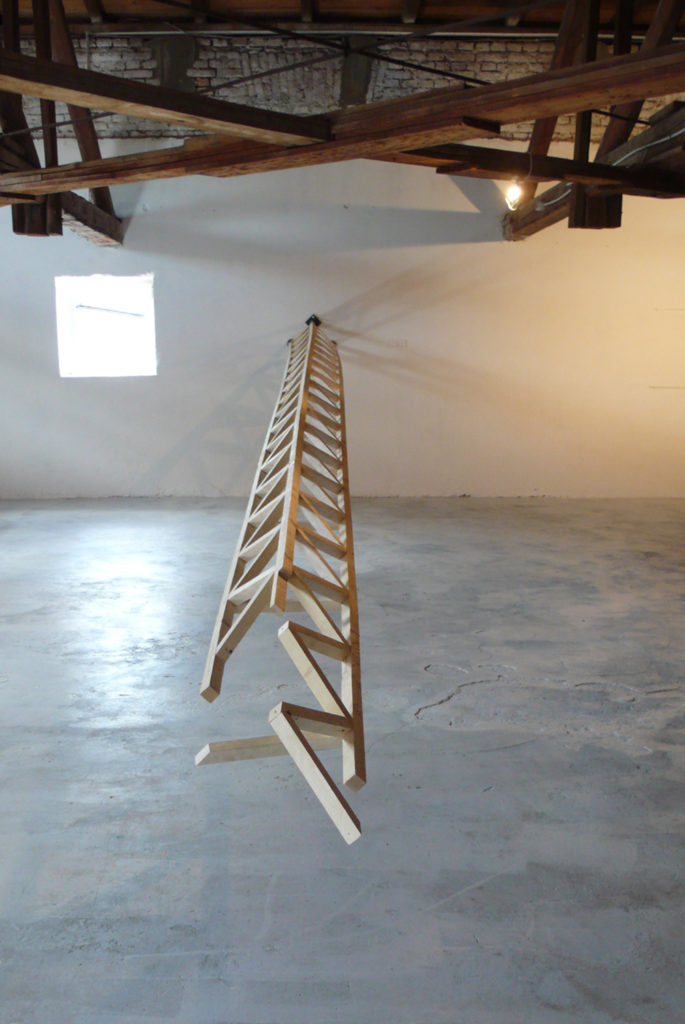
Colson Wood développe un travail de charpente expérimentale à travers des sculptures et des installations. Ses interventions explorent la frontière entre l’artisanat et l’art en testant les limites des matériaux qu’il utilise. Ses projets investissent l’architecture et l’espace grâce à un puissant processus d’hybridation. En poussant les structures physiques jusqu’à leur point de rupture, Colson Wood s’affranchit des contraintes de la charpente traditionnelle tout en mettant en oeuvre ses techniques, permettant ainsi à l’architecture propre au matériau de se révéler.
Colson Wood develops a body of work in experimental carpentry through sculptures and installations. His interventions explore the boundary between craftsmanship and art by testing the limits of the materials he uses. His projects engage with architecture and space through a powerful process of hybridization. By pushing physical structures to their breaking point, Colson Wood sheds the constraints of traditional carpentry while preserving its techniques, allowing the architecture of the material itself to emerge.


